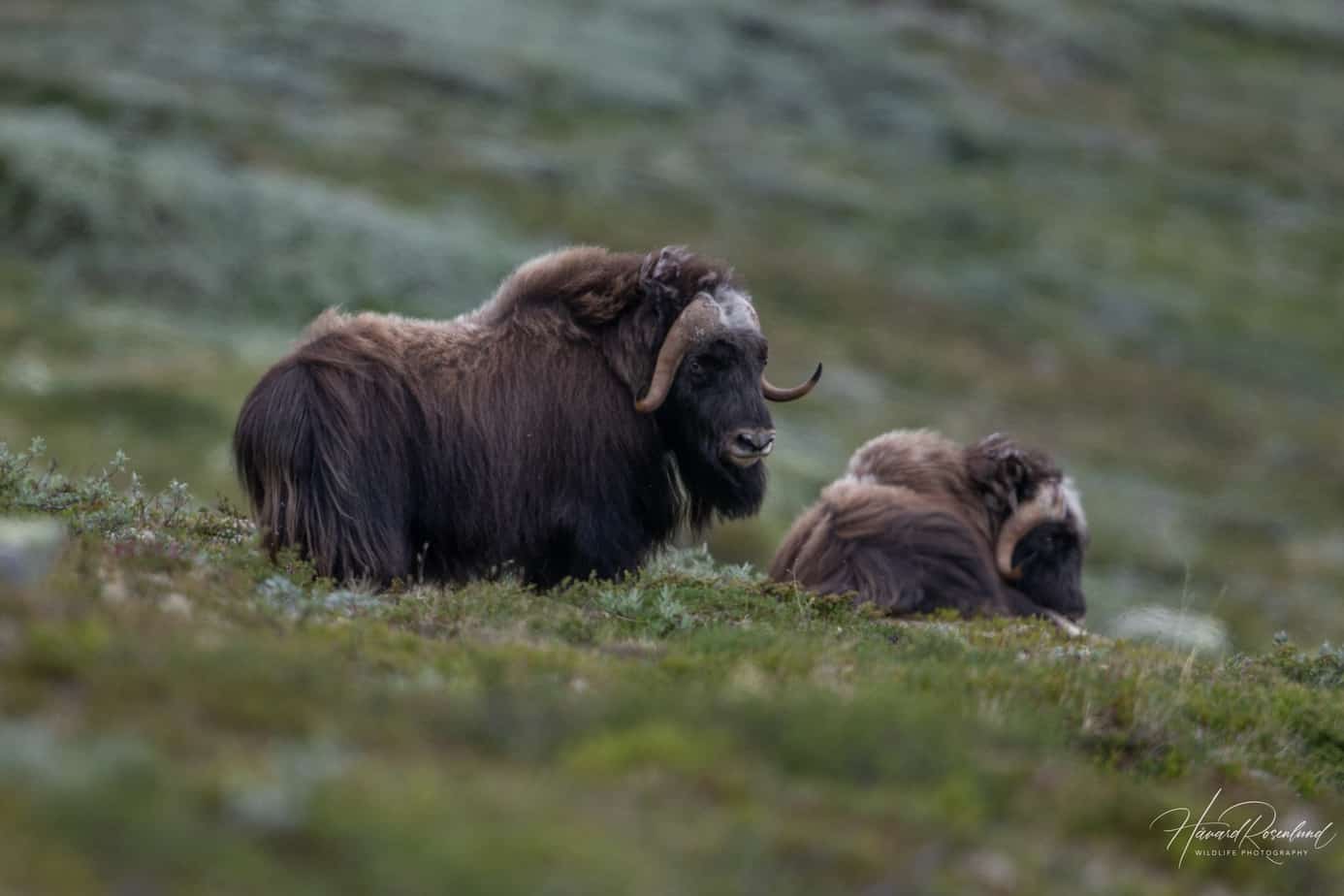
Dovrefjell – Realm of the Muskox
I can’t believe it’s been five years since I wrote an update on this website! It’s not like I haven’t been doing anything associated with the theme and purpose of this website. On the contrary! I’ve improved my photography equipment (to say the least!) and been on countless minor photography excursions. Mostly daytrips looking for birds in my local area. Obviously nothing exciting enough for an update. Kinda true, but I’ve also been lazy, aaand, last but not least, busy working as a full-time teacher (which I wasn’t five years ago). I love that job, by the way!
To write on this website, I need to have the creative juices flowing, and I need something quite special and inspiring to really set it off (it seems). In South Africa, I found inspiration around every corner, in Norway, not as much. It’s not like I find it boring here (getting into birds has done wonders), but there’s just nothing like being out on your own (in a car I might add) and bump into a pride of lions just hanging out by the road every now and then. So, I finally did the next best thing. I got into a car and drove to the place that, to me at least, most closely resembles the African plains here in Norway. The Dovrefjell mountain range. And I kid you not! During my walks up there, I had several moments when I thought to myself: «Wow! This reminds me so much of the Serengeti!» Just with a tad bit less to worry about. Fun fact: The Serengeti in Tanzania is actually at about the same elevation as Dovrefjell, but the warmer climate makes it a lot more lush and diverse.
Well, if that wasn’t the longest intro I’ve ever written!? You still here? Good! Let’s get into the trip, shall we? And of course, the photographs! The Dovrefjell wildlife practically threw itself at me for a decent photograph, which, in the end, inspired me enough to write this piece. Too many words, Håvard… Show me photos!
Here’s one of a bluethroat trying to keep its balance when the beak is too heavy with caterpillars.
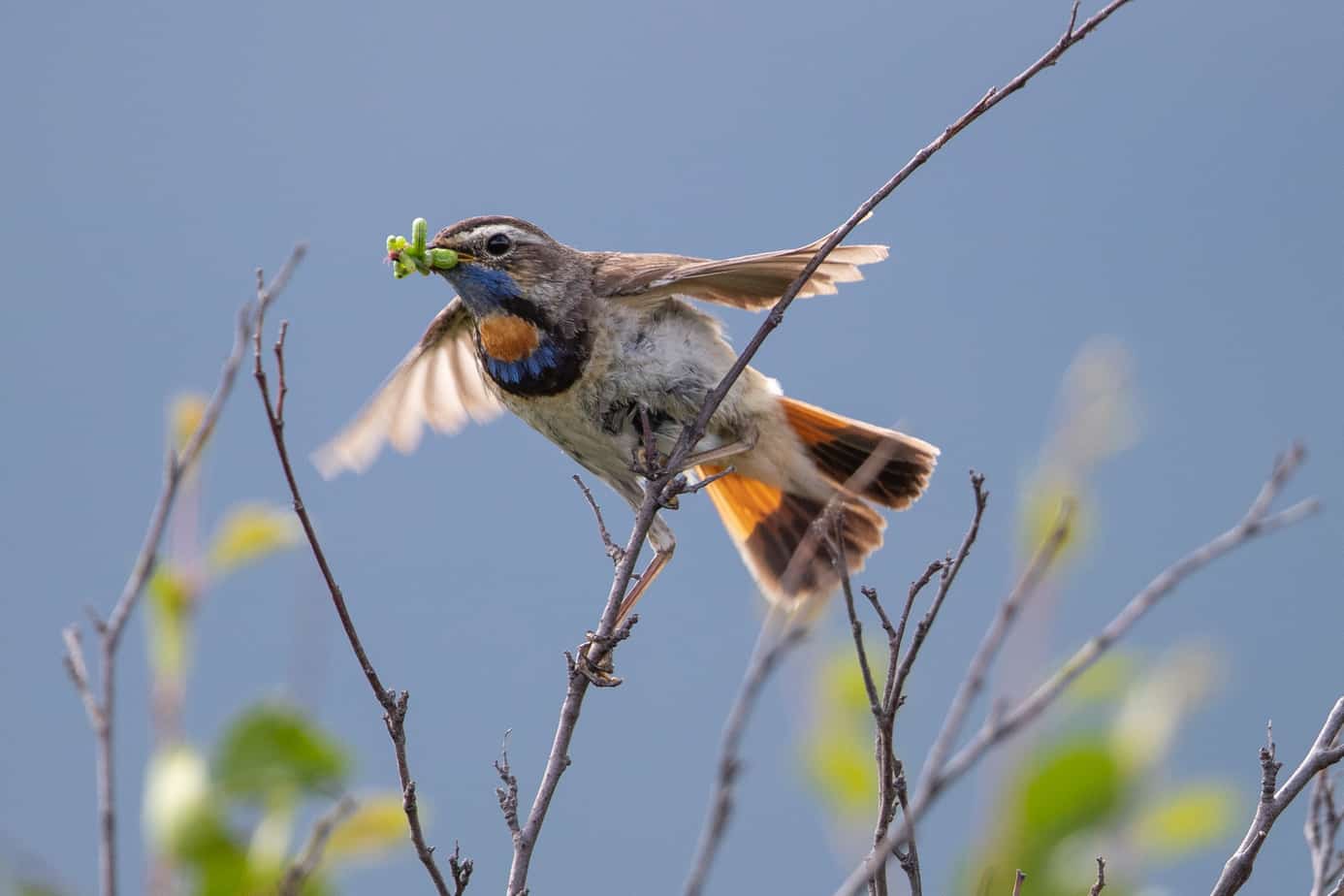
Bluethroat @ Dovrefjell-Sunndalsfjella National Park. Photo: Håvard Rosenlund
Happy now? Let’s start from the beginning:
(PS: If you want Norwegian names for the species I’ve seen I’ve made a list at the bottom (to force you through the entire post first, obviously))
Day 1 (July 5th):
During my entire stay, I stayed at a room at Trolltun Gjestegård (who also rent out cabins) at Dombås, at the southern edge of Dovrefjell. A nice enough place, decent food, but nothing fancy. I picked this particular spot because it was very close the my number one area of interest: Fokstumyra Nature Reserve. A nature reserve famous for its birds (of course).
This day really should have been blank, as I actually had no plans to go out on the first day after a long drive. However, the weather forecast for the next few days kept changing and the possibility of rains were a bit discouraging. And, of course, my trigger finger was itching. So, I decided to check out Fokstumyra and see if I couldn’t find anything interesting to fit into my lens.
Before this trip I had three goals:
- See and photograph a bluethroat (Luscinia svecica), a mountain bird I’ve always found beautiful, but had never seen
- Go on a muskox safari and hopefully see a muskox (Ovibos moschatus), and maybe even get a decent shot
- See a few other new species, but without any expectations
Just a few minutes into my very first walk at Fokstumyra, what do I see? A bluethroat on a branch right above me, showing off! My first and most important goal was met within minutes! Right then, I knew this trip was going to be something special!
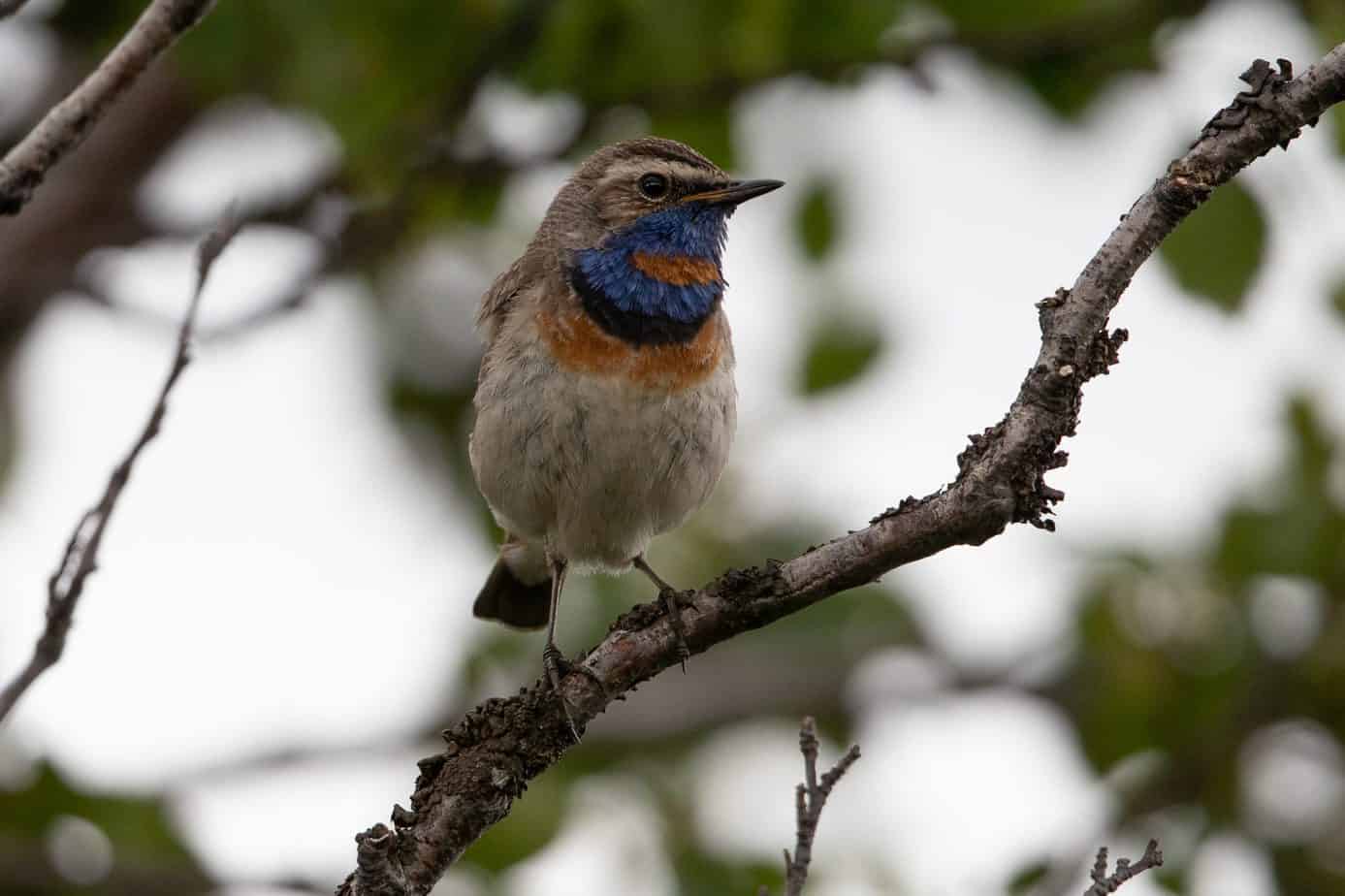
Bluethroat @ Fokstumyra Nature Reserve. Photo: Håvard Rosenlund
This bluethroat obviously had a nest nearby, and his reason (yes, only the males have that beautifully colored throat), for getting so close and to make so much noise (which he was), was to warn me and get me to leave, which I did after I got a few shots. I, however, left him feeling happy and excited to have finally seen and photographed such a nice looking bird. Brace yourself for a lot more bluethroat photos, though, as this chap was far from the last one I’d see on this trip!
A bit further along the path, towards a bird watching tower on the western side of the trail through the reserve, I also came across a first of many for this trip, a meadow pipit (Anthus pratensis). Not my best shot (a bit too cropped), but I like it:
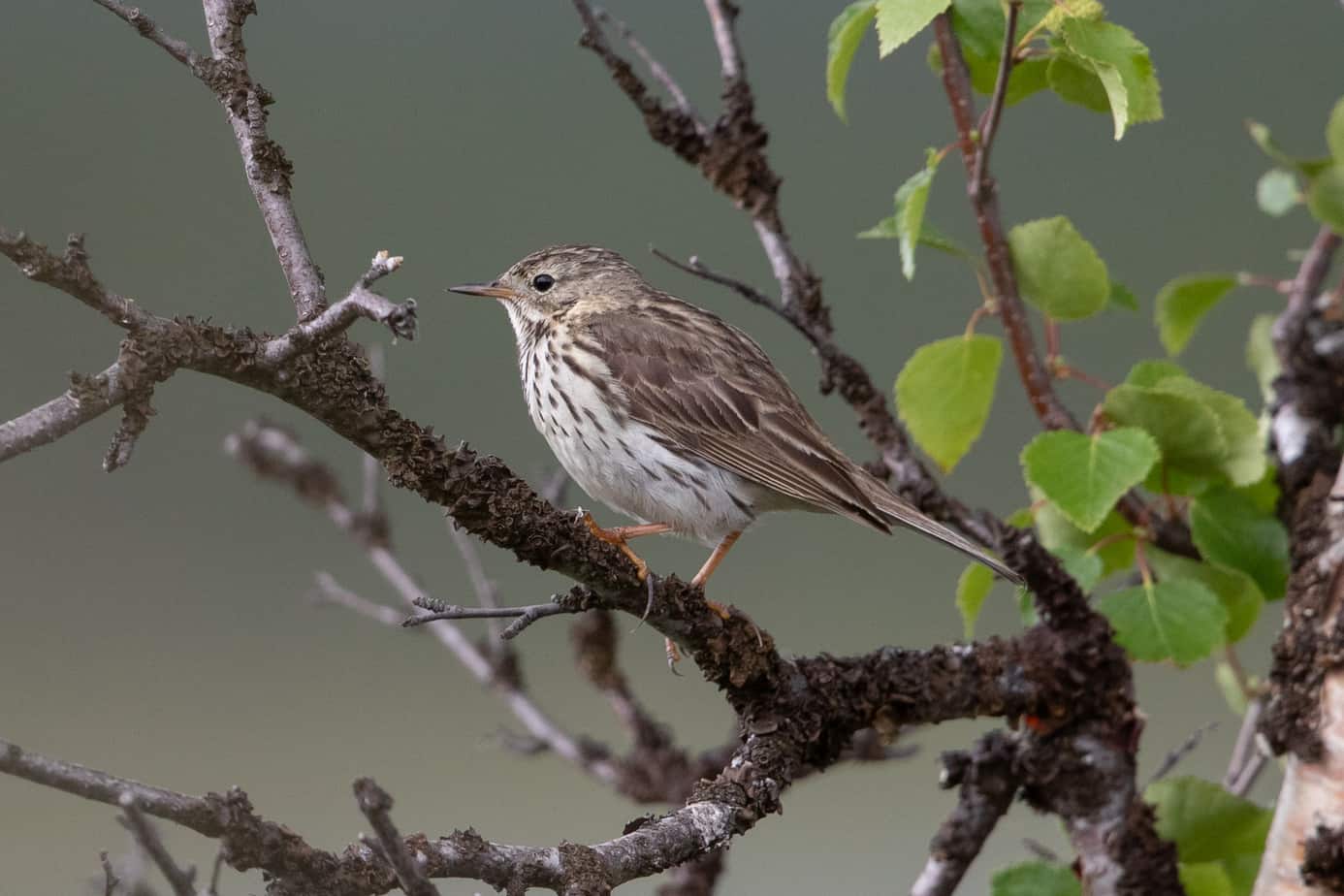
Meadow Pipit @ Fokstumyra Nature Reserve. Photo: Håvard Rosenlund
After I had passed the bird watching tower (short stop, didn’t see anything, met a few nice people, though), another beautiful male bird came by to show off and make a lot of noise. A close relative of the meadow pipit, a western yellow wagtail. This is a special subspecies, only found nesting in northern Scandinavia, Finland and Russia, Motacilla flava thunbergi. I suspected this bird of having the same agenda as the bluethroat before it, to warn me off and chase me away because of a nest nearby, but it kept following me for a long time, which I felt was a bit odd. A similar event the next day made me suspect another motive, however, so keep reading to find out! (Oh, the excitement!). He made for a couple of decent shots, though:

Western Yellow Wagtail @ Fokstumyra Nature Reserve. Photo: Håvard Rosenlund
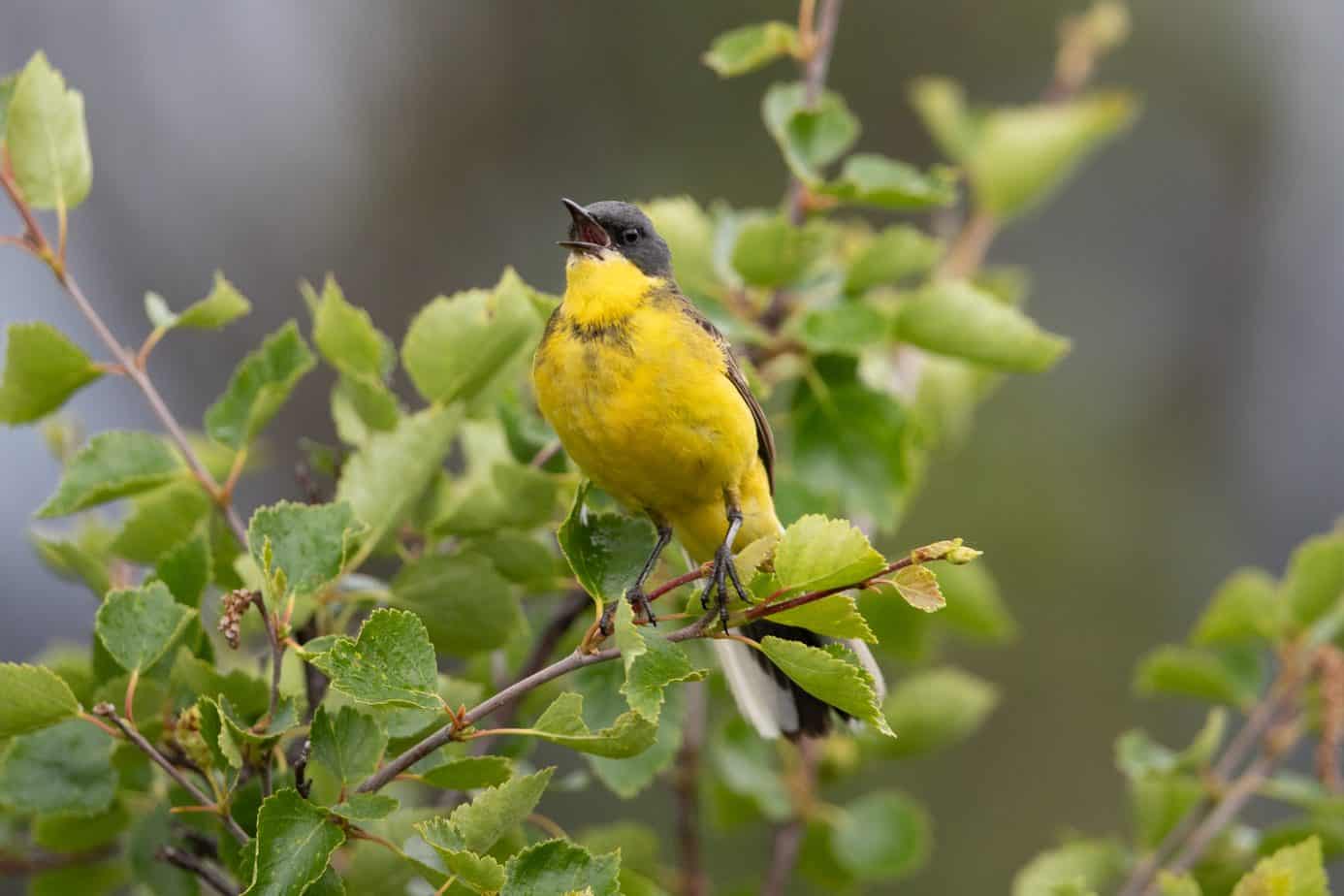
Western Yellow Wagtail @ Fokstumyra Nature Reserve. Photo: Håvard Rosenlund
In the northern part of the trail through the reserve there are a couple of small lakes, where I got to see a new species for me, the Arctic loon, also known as black-throated loon (Gavia arctica). A very cool bird, but sadly way too far for any decent shots. I’ll add my crappy one anyway (because, why not? It’s my first one!):

Arctic Loon @ Fokstumyra Nature Reserve. Photo: Håvard Rosenlund
I continued on and a whooper swan (Cygnus cygnus) flew over (before a lot of exciting stuff happened):

Whooper Swan @ Fokstumyra Nature Reserve. Photo: Håvard Rosenlund
I promised a lot of exciting stuff now, so let’s start with the photograph of this lady right here:
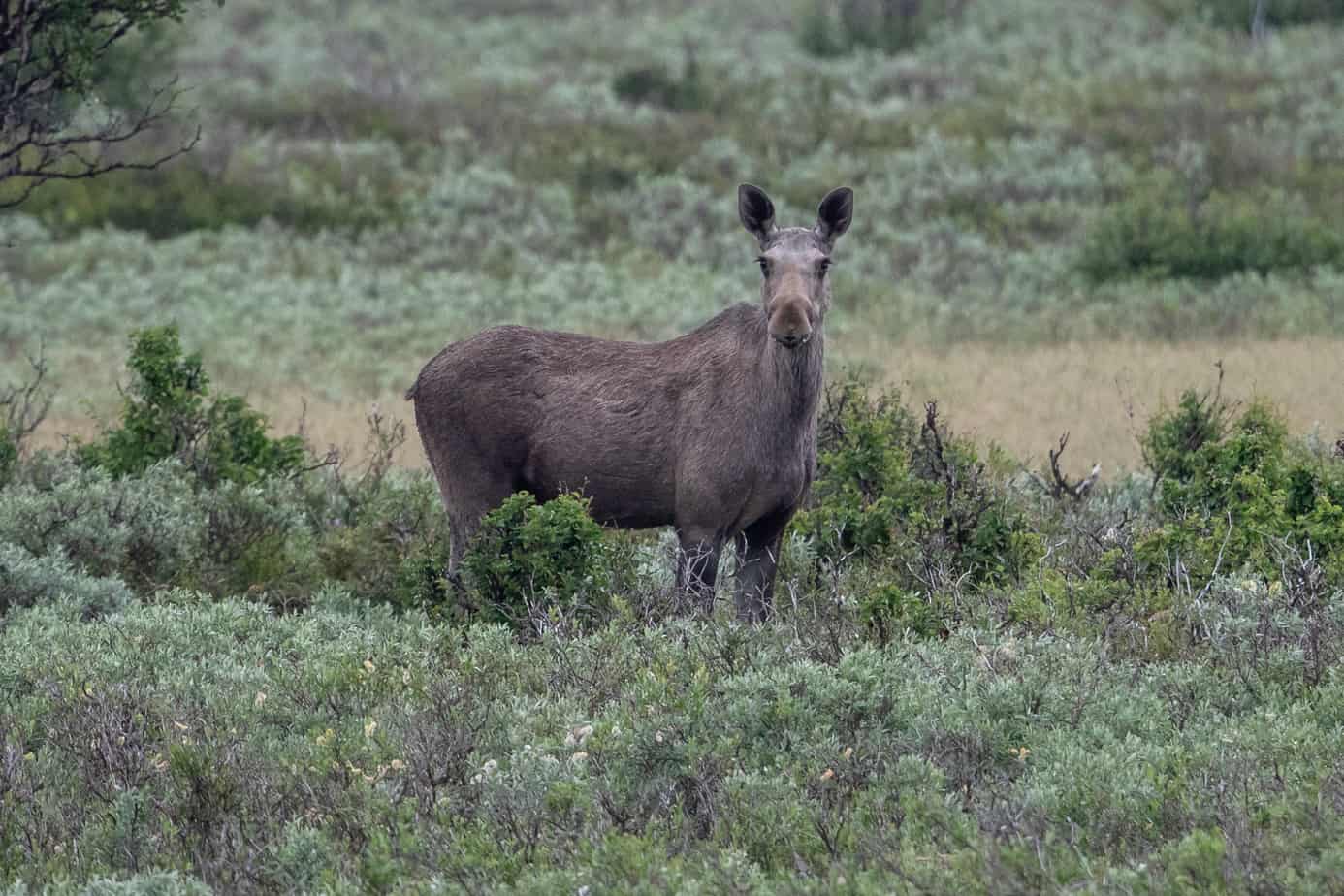
Moose @ Fokstumyra Nature Reserve. Photo: Håvard Rosenlund
At first I only saw this one female moose (Alces alces) (yes, I am a biology teacher, I need to add Latin species names in italic every time I introduce a new species in the text). As I got closer it turned out she was not alone, as there must have been at least six moose of various sexes and ages, but they all saw me before I saw them and ran before I could get any photos. A small bit of excitement there!
Now for the really exciting (and a tad bit embarrassing) bit. Remember the whooper swan just above? Well, it and its partner decided to land in a pond out in the marshes (most of the reserve is marshlands) a few hundred meters in front of me. A lot of noise and ruckus happened, and I soon saw the two swans fly away again. That should have been my warning. As I approached this pond myself, a very familiar sound from back home, but more intense and desperate, suddenly came from above. I looked up and there it was, one of the scariest wild animals I’ve ever come across: a common gull (Larus canus). Yes, the exact same species of gull we have in Oslo (and around the school I work at for that matter). But this was no ordinary specimen. This was a terror gull! It was not used to people, as they often are, and it had a nest with chicks nearby and I was clearly way too close.
My path seemed to take me straight past the nest, and even though I kept on walking, the gull was not happy until I ran. And ran I did! With a heavy camera in hand, and a heavy backpack, I stumbled across uneven terrain as fast as I could, fearing twisted ankles and broken equipment at every step. I finally hit a patch of forest were the gull couldn’t dive at me anymore through the trees. Fear struck me again as the path suddenly turned south, as it meant I had to walk past the pond when I got out of the forest again. I prayed that I was far enough away from the nest when I got out in the open. My prayers were not heard. I looked to my right and saw a winged white devil fly straight at me, not from above this time, but at eye level. My only option now was to run off the path and straight into the marshlands, hoping desperately that I wouldn’t hit water. It must have been quite the scene, and someone definitely should have been there with a drone filming me run off into the marshes like that, but I had a bit of luck at least. My feet never got wet. The rest of me did though. I was soaked in my own sweat, which attracted half the mosquitoes in the entire reserve… Finally, at a safe distance away from what felt like certain death, I finally found a rock where I could catch my breath. As I sat down, I looked straight at another moose! At that point I thought: «I give up!» Luckily for me, the moose was more interested in feeding than me, and when he finally figured out I was there he decided to run away from me for a change. Then I went straight back to the car, and got a short-eared owl (Asio flammeus) on the way! How’s that for a first day!?
I never got a photo of the gull that chased me (obviously), but here’s a photo of his kin (a friendlier fellow):
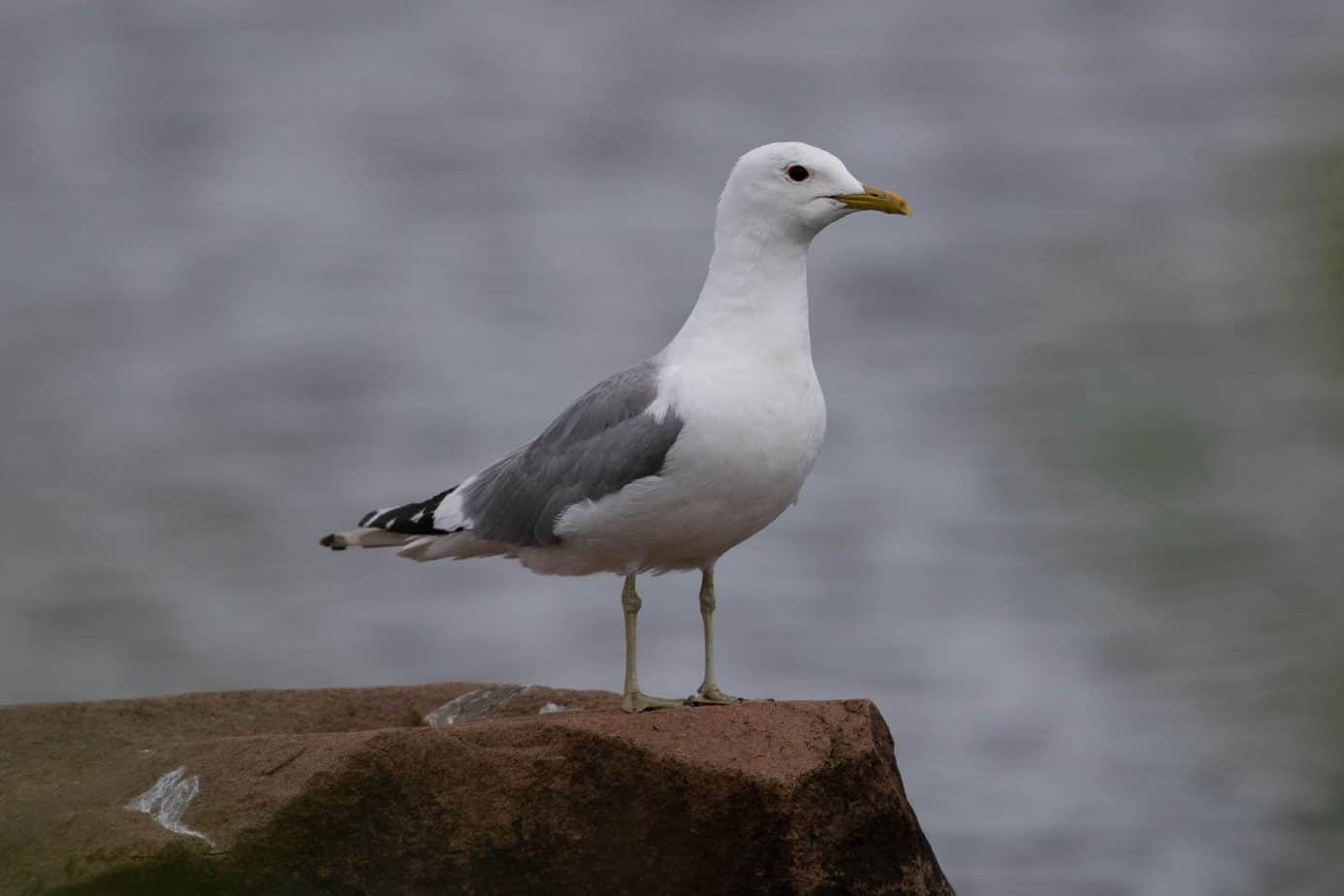
Common Gull @ Fornebu, Norway. Photo: Håvard Rosenlund
Day 2 (July 6th):
As was expected, the day began with heavy rains. I normally go out as early as I can when doing wildlife photography, as wildlife tend to wake up a lot earlier than us, and many go to bed before we even wake up. I didn’t feel like getting myself or my equipment drenched, so I decided to wait it out and leave a bit later when it cleared. I left for another walk at Fokstumyra without too much expectation some time after 10 AM. I had but only one clear objective: Avoid the terror gull from the day before.
My timing was spot on, as the first thing I saw straight out of the reserve parking lot was a bird that is notoriously shy and seldom seen, but often heard. I can wager that most of you reading this (especially you Norwegians) can tell this species by its sound, but surprisingly many would not be able to tell you what it is based on a photograph, as hardly anyone sees it (except us birders of course). Based on this less than adequate photo, can you tell what it is?

Common Cuckoo @ Fokstumyra Nature Reserve. Photo: Håvard Rosenlund
If you said common cuckoo (Cuculus canorus) (that’s gjøk to you Norwegians), then you’d be right, and count me impressed (unless you’re a birder, then I’m not impressed). I love the cuckoo, but I also hate the damn thing. This is the best photo I have ever gotten. I once spent several hours tracking a cuckoo in the forests back home, and every time I got a glimpse of it and tried to get a photo, it flew away. It’s like it knows when it is being watched, even when you hide behind trees! This one was no better. Although it stayed in the open, it always flew just out of reach for a good photo at my every approach (no matter how slowly I walked towards it). Still, it was very cool to catch a glimpse of it and to get some sort of photograph at least.
I ended up trying to get to the cuckoo from another angle, approaching slowly from behind some bushes. The cuckoo, alas, was never to be seen again, but this approach ended up giving me another pleasant surprise. Suddenly a large bird appeared over the field in front of me. A species I saw for the very first time the evening before, but this time it got way closer and I ended up getting a nice photo (although far from great, as it didn’t get that close). This was a short-eared owl, one of very few owls that actively hunt during the day (mainly early morning and evening). This was actually my very first owl sighting in Norway (I’ve heard them), so to me this was very exciting!

Short-eared Owl @ Fokstumyra Nature Reserve. Photo: Håvard Rosenlund
As I approached the place I’d seen the bluethroat the day before, I wondered if the same male would jump out again and give me the same show it did the day before. And lo and behold, it did! I rarely get this close to birds, but when it happens, the camera and lens really show their worth:

Bluethroat @ Fokstumyra Nature Reserve. Photo: Håvard Rosenlund
I also go this rare shot of a female bluethroat:
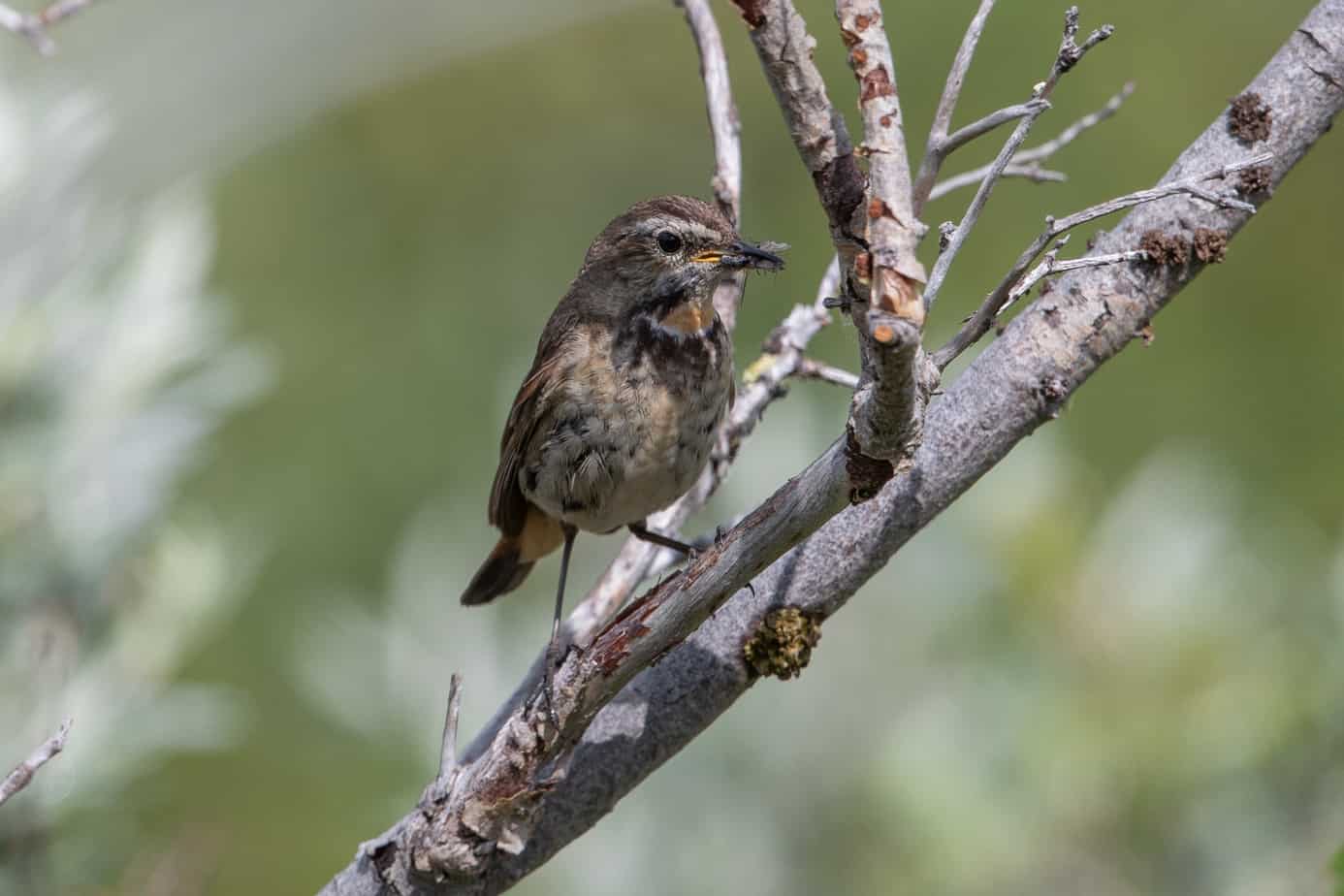
Bluethroat @ Fokstumyra Nature Reserve. Photo: Håvard Rosenlund
This day I had the bird watching tower to myself, and decided to stay a bit and eat my lunch. As I sat there three moose decided to pass by, a mother and her two calves. It almost felt like I was back in one of the wildlife hides in an African reserve, watching large animals pass by as I sat there with my camera.
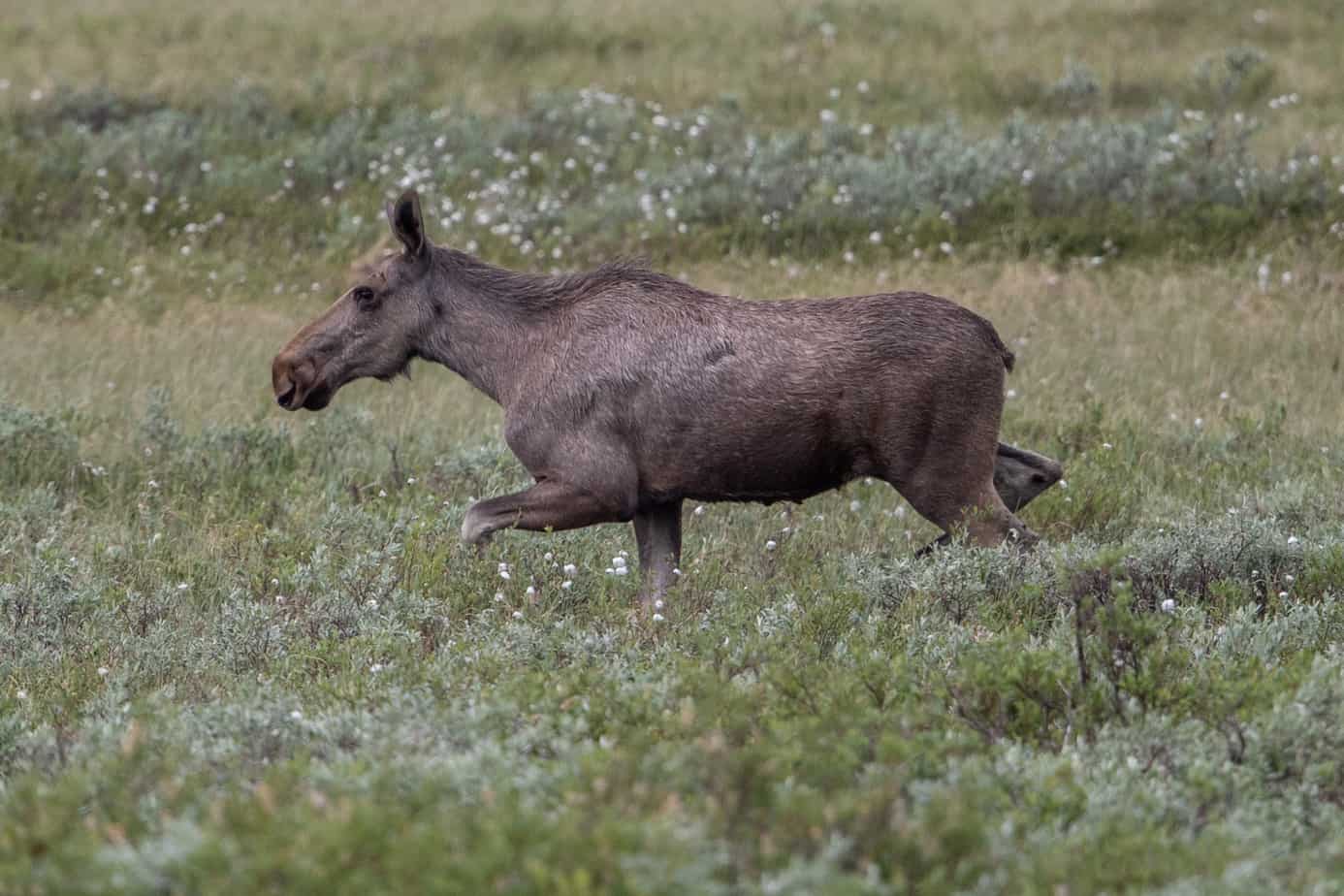
Moose @ Fokstumyra Nature Reserve. Photo: Håvard Rosenlund

Moose (calf) @ Fokstumyra Nature Reserve. Photo: Håvard Rosenlund
Happy with my bird(moose?) watching tower experience I decided to continue onwards. As I approached the place I’d seen the western yellow wagtail the day before, which had followed me for so long, I wondered if I’d see it again. A familiar sound came from the trees, but what appeared was decidedly not the same bird as I’d seen the day before. Same sound, different colors. This was the lady! The funny thing is, it did the exact same thing as the male did the day before. It kept making a lot of noise and followed me for a long while. This time, however, I noticed something I didn’t the day before. As I walked, I had many flies and insects around me. Some of them disturbed by me moving past them, causing them to fly. Then I suddenly realized that the wagtail actually swept down and caught these insects as she followed me. Very clever, and a behavior I’ve seen before in some African bird species.
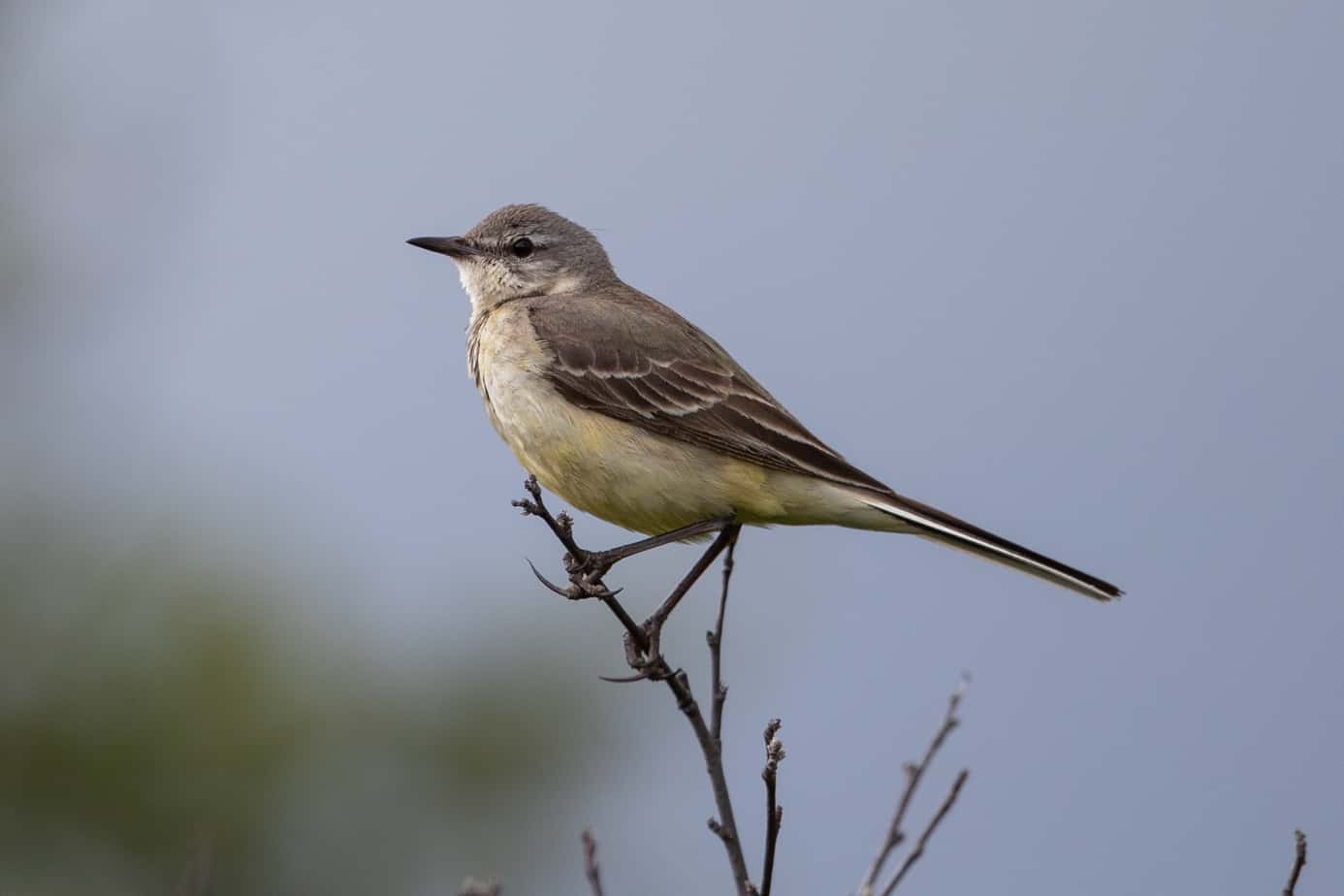
Western Yellow Wagtail @ Fokstumyra Nature Reserve. Photo: Håvard Rosenlund
As the lady wagtail finally left me I walked just a few hundred meters along the path before a loud noise made me suddenly halt in my tracks. It was some kind of bird, which made a sound I did not recognize. It was right there in front of me, but I couldn’t see it. By the sound it was definitely not a small songbird. There were no trees around (no tall ones at least), so it had to be hiding in the vegetation somewhere. I kept looking and looking, but I couldn’t see a thing. Eventually I gave up and decided to move forward. I’d probably scare it and it would fly out, revealing itself, but chances for a photograph was next to none. I was halfway right. I did scare it, and it did fly out and reveal itself, but to my surprise it decided to land on top of a young birch just next to me on the other side of the trail. It was a wood sandpiper (Tringa glareola). A brand new species for me! And it ended up being one of the craziest photo opportunities I’ve ever had! I hardly had to crop the photo at all, as it was so close.
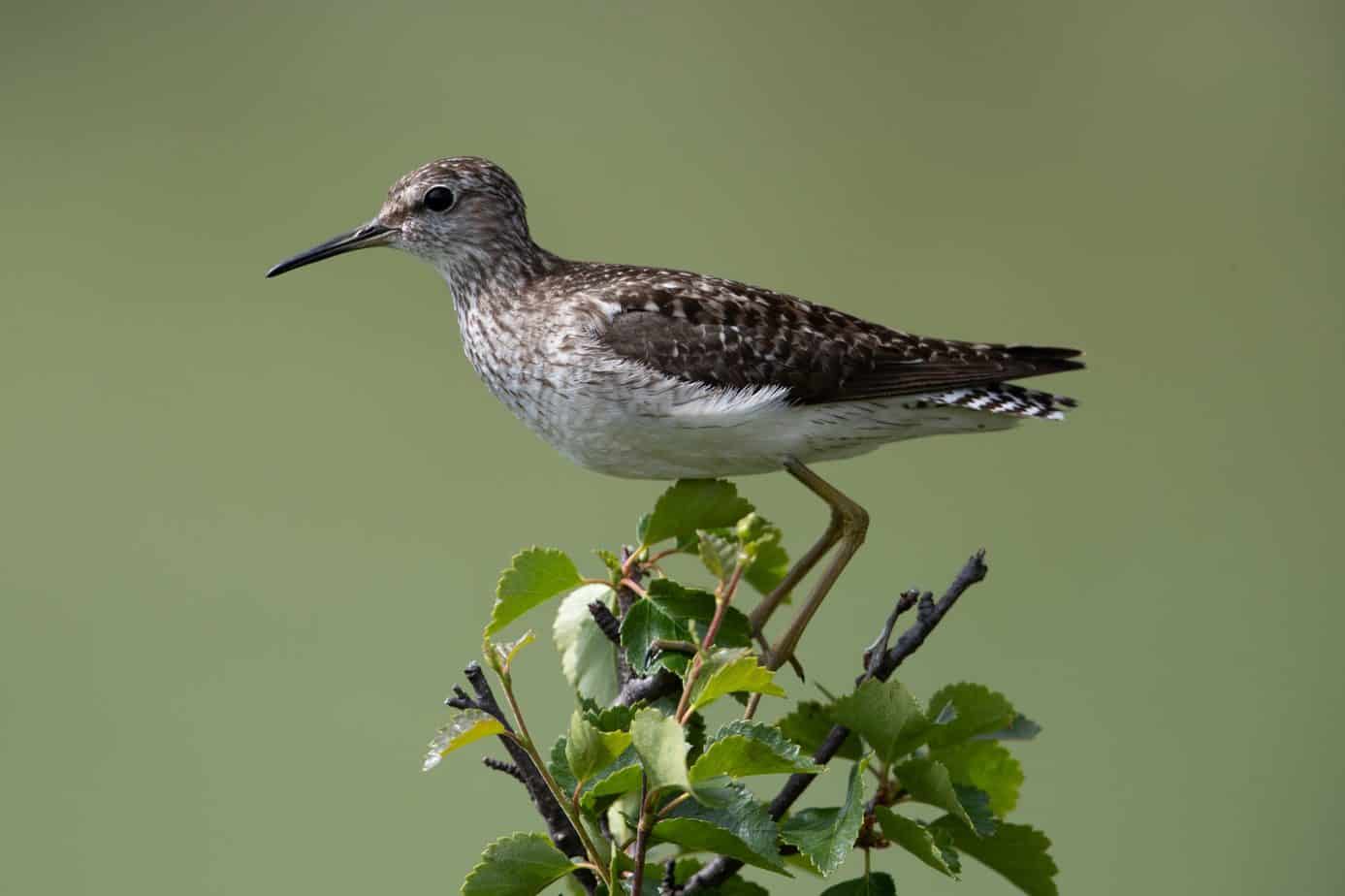
Wood Sandpiper @ Fokstumyra Nature Reserve. Photo: Håvard Rosenlund
Filled with adrenaline from a very unusual but exciting encounter, I moved on and decided I would find a place by the small lake I saw the Arctic loon the day before and just sit there camouflaged and wait for whatever appeared. Before finding a nice place to sit down, I came across this nice little thing. A female common reed bunting (Emberiza schoeniclus). Sadly I didn’t get a good shot of the male, which is a bit more striking in coloration, but again, I rarely get birds this close, so I was very happy with this one.
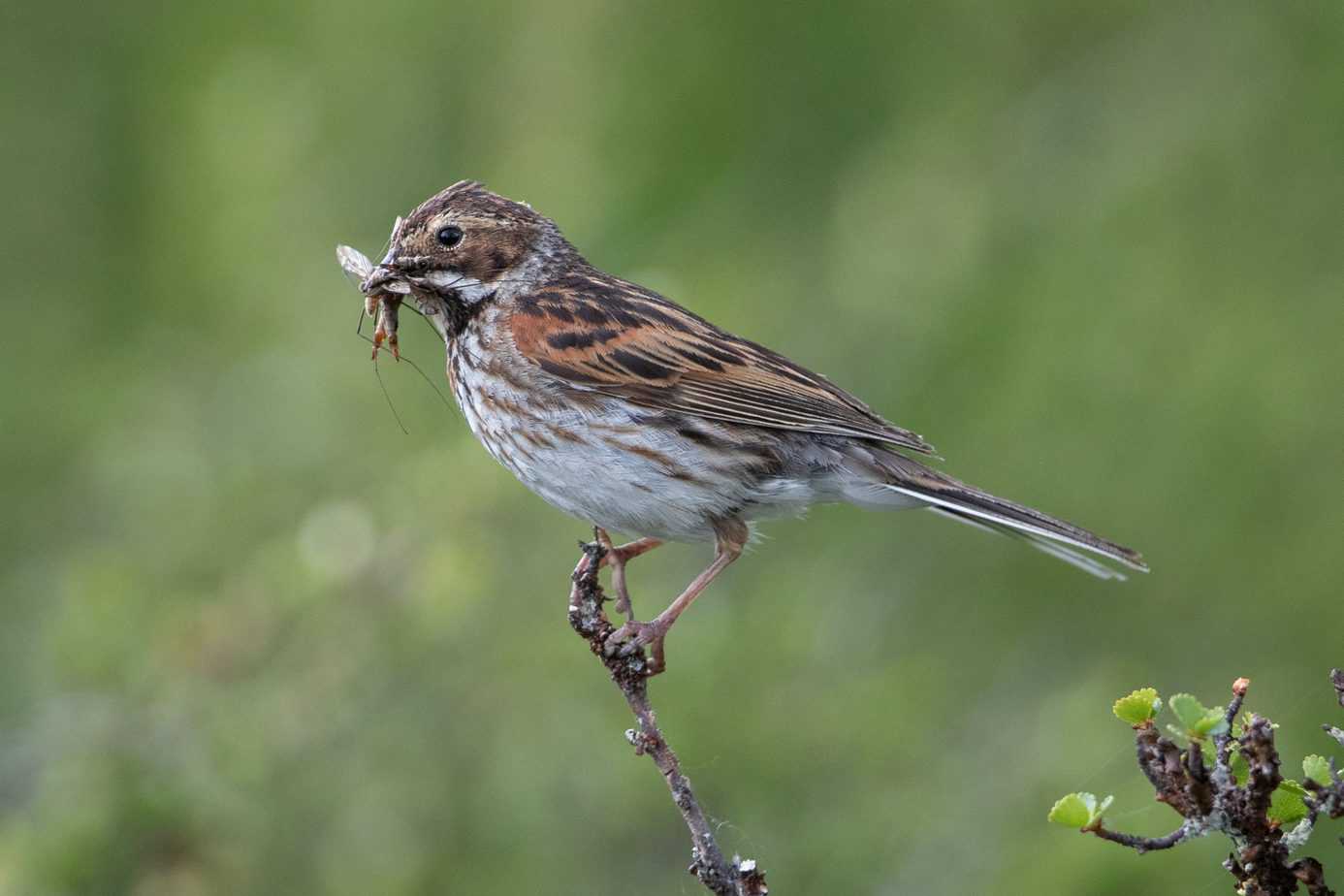
Common Reed Bunting @ Fokstumyra Nature Reserve. Photo: Håvard Rosenlund
Of course another bluethroat appeared as well!

Bluethroat @ Fokstumyra Nature Reserve. Photo: Håvard Rosenlund
When I finally found a place to sit, some very ominous clouds came rolling in from the south, and I realized that if I stayed, I’d be wet and miserable. My trip for the day was thus cut short. Not before I actually ended up wet and miserable though, but hey, that’s how it goes when «working» out in nature. I was still more than happy with the day!
Day 3 (July 7th):
This was muskox safari day! A day I had been looking forward to for a long time! I had never seen a muskox, but had dreamt of seeing one since I was a little kid, as we always passed through Dovrefjell on the way to and from visiting family in Trondheim every summer. The weather was going to be a bit of everything, but I didn’t mind. I’d heard muskox was pretty much guaranteed, so that was all I cared about.
In terms of photography, this day is probably one to forget, but I’ll add a few photos to support the narrative
I won’t get too much into the details concerning the muskox safari (it would probably end up being too many words and too little content), but I’ll give you the gist of it. I drove to Kongsvold Fjeldstue (you can stay overnight there as well), which is about a 30 minute drive from where I stayed and at the other end of Dovrefjell. At about 10 AM, a guide came with a bunch of other people he picked up from other accommodations. We all began walking up the mountain from there. He stopped here and there, to allow people to rest and catch their breath, and gave a lot of interesting information on the plant life, wildlife and general nature of the place, and of course everything we needed to know about muskoxen, at least all we needed to know to survive if we suddenly came across one.
It ended up being another highlight for me, as I thoroughly enjoyed the guided tour and the company of the other guys on the safari. It wasn’t until we got above the tree line that things became really interesting, nature-wise. At least for me. The landscape up there was simply stunning. I even got a new bird species up there. One I had hoped to see, the beautiful European golden plover (Pluvialis apricaria) (you’ll see photos on day 4).
As we kept moving upwards, it was clear the guide had an idea of where we’d have the greatest chance of spotting muskoxen. Far away in the distance there was a mountainside, which we were walking straight towards. As we slowly approached, one of my fellow safarigoers actually managed to spot a couple of small dark dots far away on the mountainside. Even with binoculars the guide couldn’t be sure, but thought it could very well be muskoxen. I managed to find the area with my camera and took a photo. As I zoomed in on the photo I could confirm that it was indeed a couple of muskoxen. Tord, if you’re reading this, kudos to you for spotting them! As you proved multiple times on the safari, your ability to spot things far away and discern them in the landscape rivals even the best safari guides I met in Africa (and he wasn’t even the guide). Anyways, here’s my very first look at muskoxen, through my lens (can you spot them?):

Muskox @ Dovrefjell-Sunndalsfjella National Park. Photo: Håvard Rosenlund
After confirming they were indeed muskoxen, our guide took us off the trail and on a path straight towards them. After a while we turned to the right to end up around 200 meters to their right (as close as we were allowed to go), where we would take photos and eat lunch. Finally at the journey’s end, this was what met us:
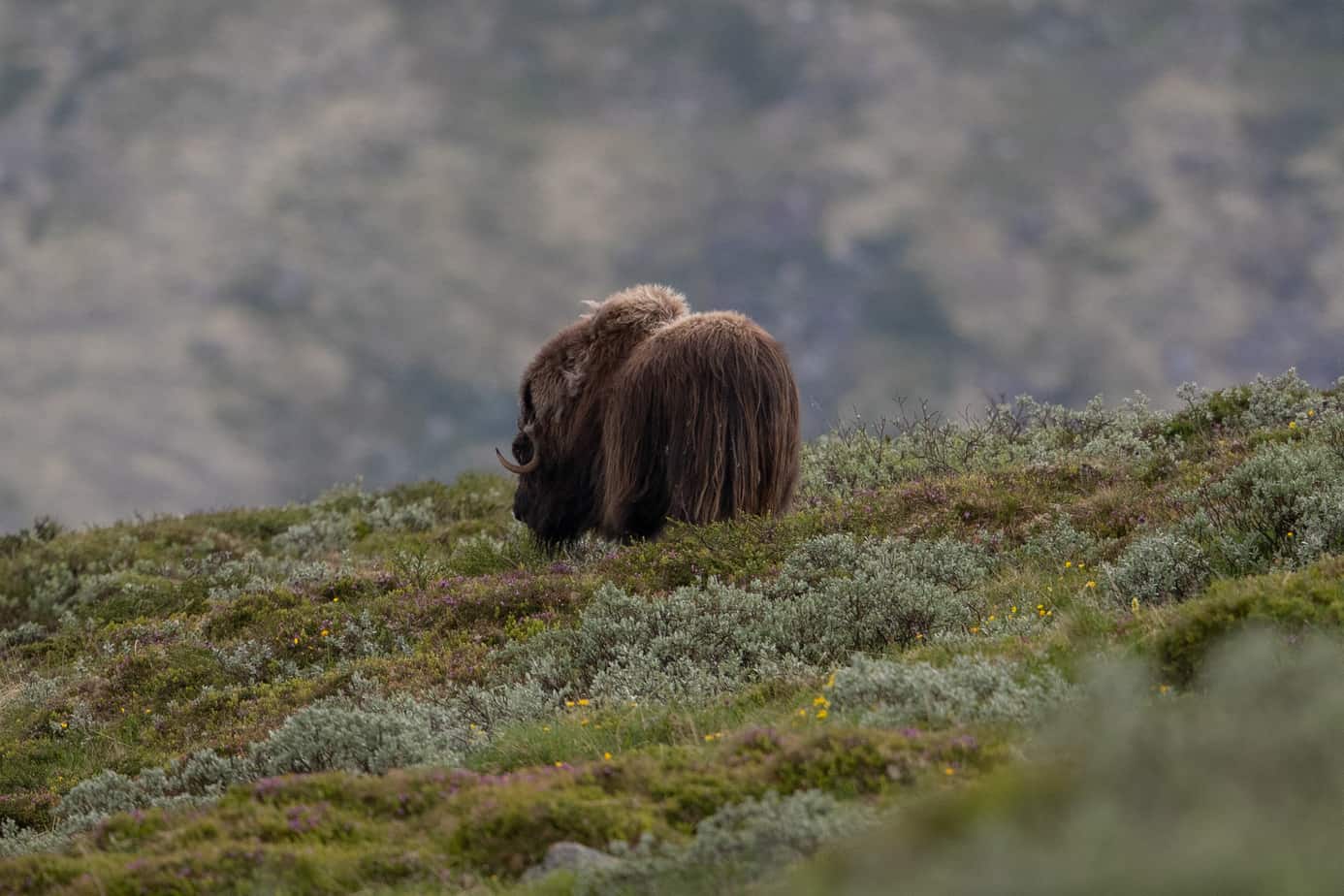
Muskox @ Dovrefjell-Sunndalsfjella National Park. Photo: Håvard Rosenlund
This is the best shot I got, before they decided to walk away, never to be seen again (that day at least). Our guide thought we would find them again after lunch, but, sadly they were gone, and many were understandably too tired to go after them. Still, I enjoyed it immensely, and will recommend it to anyone who hasn’t seen a muskoxen (and also want to learn a few things when walking in the mountains).
On the way back I got this photo of a northern wheatear (Oenanthe oenanthe) (also common at Fornebu, near Oslo, where I often go birding). I found the scene quite nice with the colorful rock (which has obviously seen its fair share of fertilizing from defecating birds).
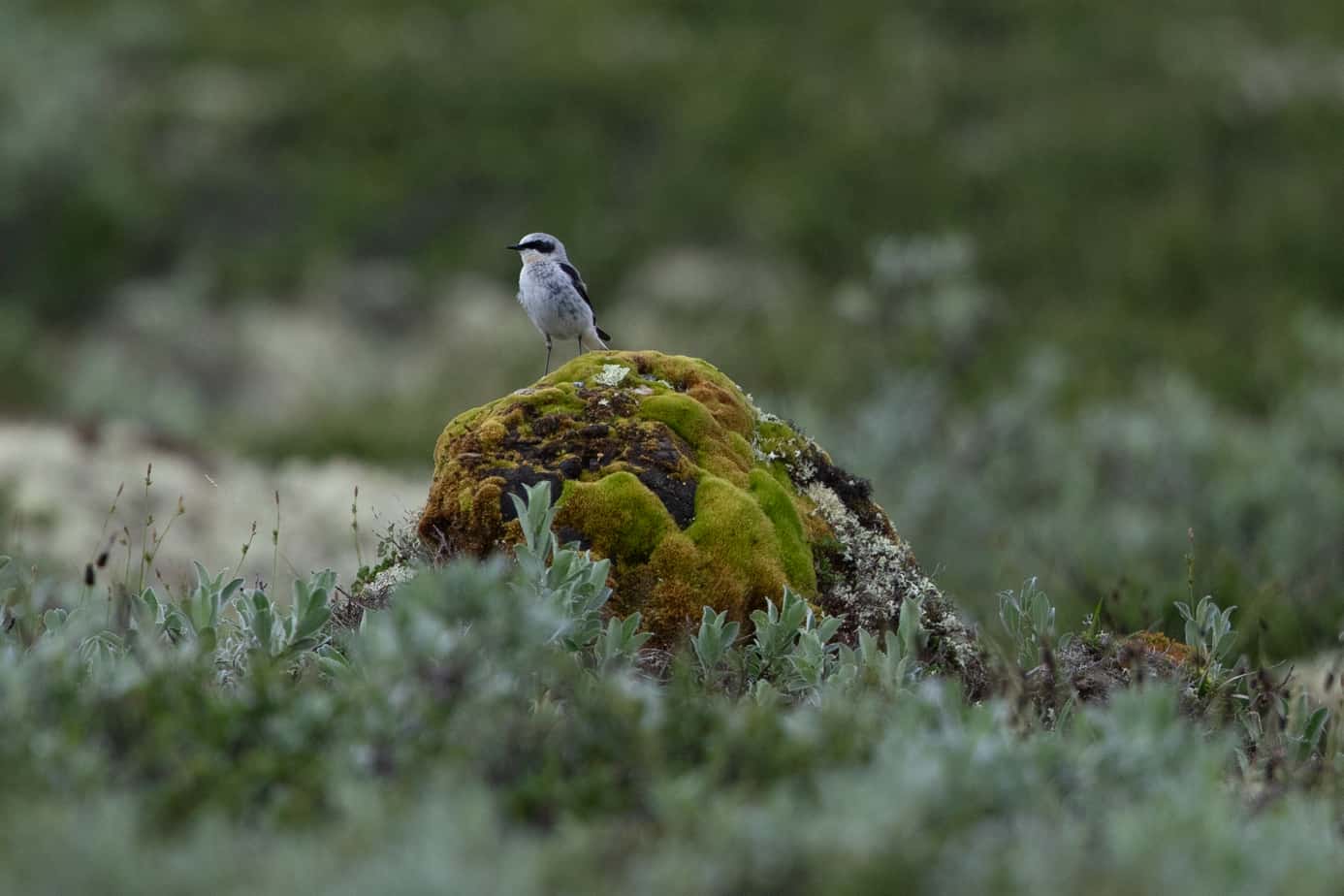
Northern Wheatear @ Dovrefjell-Sunndalsfjella National Park. Photo: Håvard Rosenlund
Day 4 (July 8th):
Probably my favorite day, and one I really hadn’t planned at all. It was really supposed to be another day at Fokstumyra, but I loved the walk up the mountain the day before, and I really wanted another go at getting a good image of the muskoxen, and also of the Europan golden plover, which was plentiful up there. I therefore decided to drive back to Kongsvold and do the same walk as the day before, but this time I wanted to start early, before most people would be walking up there. This day also promised sunshine the entire day, a first for the trip!
I parked the car at Kongsvold 07:30 AM, a bit later than I wanted, but a decent time up in the mountains. I kept a steady pace up to an area where I could see the same mountainside where the muskoxen had been the day before. Up here I used my lens to scout the area. As I couldn’t see any muskoxen I decided to focus on the European golden plovers, which were everywhere up there. I first got a female (top photo), before I got the slightly more striking male (bottom).

European Golden Plover (female) @ Dovrefjell-Sunndalsfjella National Park. Photo: Håvard Rosenlund

European Golden Plover (male) @ Dovrefjell-Sunndalsfjella National Park. Photo: Håvard Rosenlund
Satisfied with the plovers, I decided to head towards an area where people supposedly often see muskoxen. On the way there, however, I got sidetracked by a strange bird that kept doing flyovers before landing at different spots, and it made a hell of a ruckus as I came closer. After I got a photo I could inspect, I realized this was another new species for me! A common redshank (Tringa totanus), a cousin of the wood sandpiper the day before. I never managed to get too close, and it seemed a bit distraught, so I didn’t want to worry it for too long, but I got this as proof at least (a bit cropped, but hey, a new species!):

Common Redshank @ Dovrefjell-Sunndalsfjella National Park. Photo: Håvard Rosenlund
After the redshank, I decided not to keep walking in that direction, but instead turn towards the area where the two bull muskoxen from the day before had been headed. As I kept walking, not really keeping my hopes up, I looked up at the mountainside, and there they were! The exact same muskoxen as the day before, just a bit further south. Ok, so now I had found them. How to get up to them and actually photograph them? Luckily for me, I had picked up a thing or two about muskoxen behavior the day before from our guide. I realized these animals were nothing like the African buffalo, who attacks first and asks questions later. Muskoxen just like to be left alone, and like to have their own space. If you do not respect their space, they will warn you with snorts and a behavior that shows obvious discontent. If you keep disrespecting their space, they can very well attack. And with a speed of up to 60 km/h, that is nothing you want to have happen! Safe to say, I wouldn’t have done this alone if it wasn’t for my experience with large and dangerous animals in Africa. You have to know what you’re doing and be able to read animal behavior.
I decided to not approach them head on, but to walk up the left side of the mountain and reach their elevation, and then slowly make my way towards them from there, hopefully being able to have my eyes on them for most of the time. At this time I was also incredibly hungry, and had to stop for a bite of food before doing anything else. I decided to eat my lunch at the base of the mountain, sitting on a rock there. I took this photo with my phone from there. Just an incredible view!
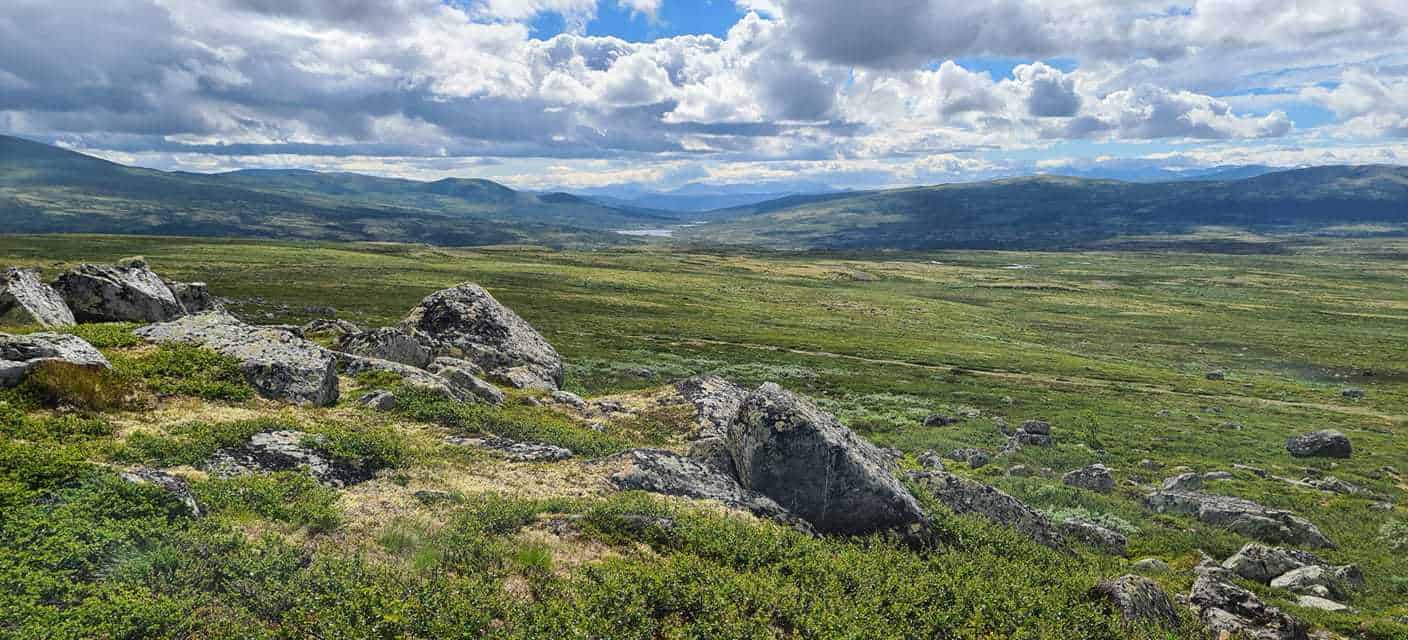
Dovrefjell-Sunndalsfjella National Park. Photo: Håvard Rosenlund
To my dismay, my perfect lunch spot was also a spot where the two muskoxen had disappeared from view, as they were above a ledge I couldn’t see past from my angle. When last I saw them, they had laid down to rest, so I hoped that was what they were doing still. After I’ve had some food and a short rest, I began my walk up the side of the mountain. Since I now had no clue as to where they actually were, I decided to walk away from them as I walked upwards, as I felt that was the safest option. I didn’t want to suddenly walk straight into them as soon as I got above the ledge. I also took lots of small stops to look around as I walked upwards, as there could be other muskoxen around that I hadn’t seen yet. I finally managed to get up to the elevation where I thought the muskoxen would be, but I still couldn’t see them. I had gotten up on the other side of a slight corner in the mountainside. This meant they had to be past that corner somewhere, but I had no clue as to how close they would be on the other side. After doing some thinking on how to best approach the situation I decided to walk slowly towards said corner, hoping what was on the other side would be revealed bit by bit as I walked towards it. Luckily for me, that was exactly what happened, and as I kept walking slowly, a dark and hairy brown back suddenly appeared in my view. A muskoxen was resting about a 100 meters from me (maybe closer, we humans are notoriously bad a telling distances). I knew there were two, so before I could do anything else, I had to make sure of where the other was as well. A little walk up the mountain revealed it was lying next to the other. Then I could finally start taking my photos!
For some weird reason, none of the photos came out sharp. I had accidently switched a switch on my lens that helped with stabilizing and focus, but turning it back didn’t help. Most likely the distance made heat waves from the ground obscure the picture a bit (it was warm and sunny), which happens when using such large lenses. Anyway, I got some decent shots (including the featured image at the top of this article), especially after one of them reacted to my presence and stood up (but showed no sign of aggression). I had full focus on their body language the entire time.
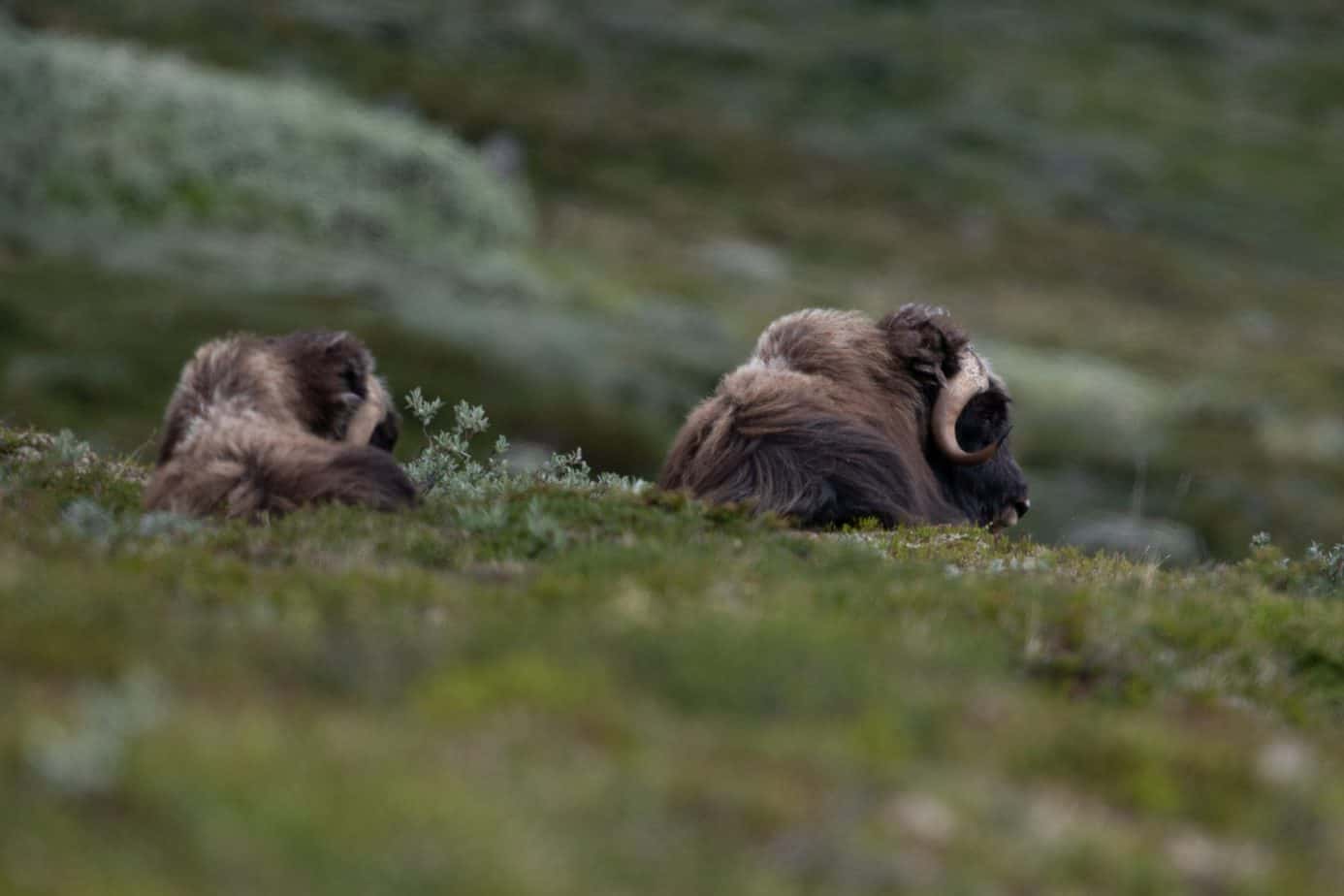
Muskox @ Dovrefjell-Sunndalsfjella National Park. Photo: Håvard Rosenlund
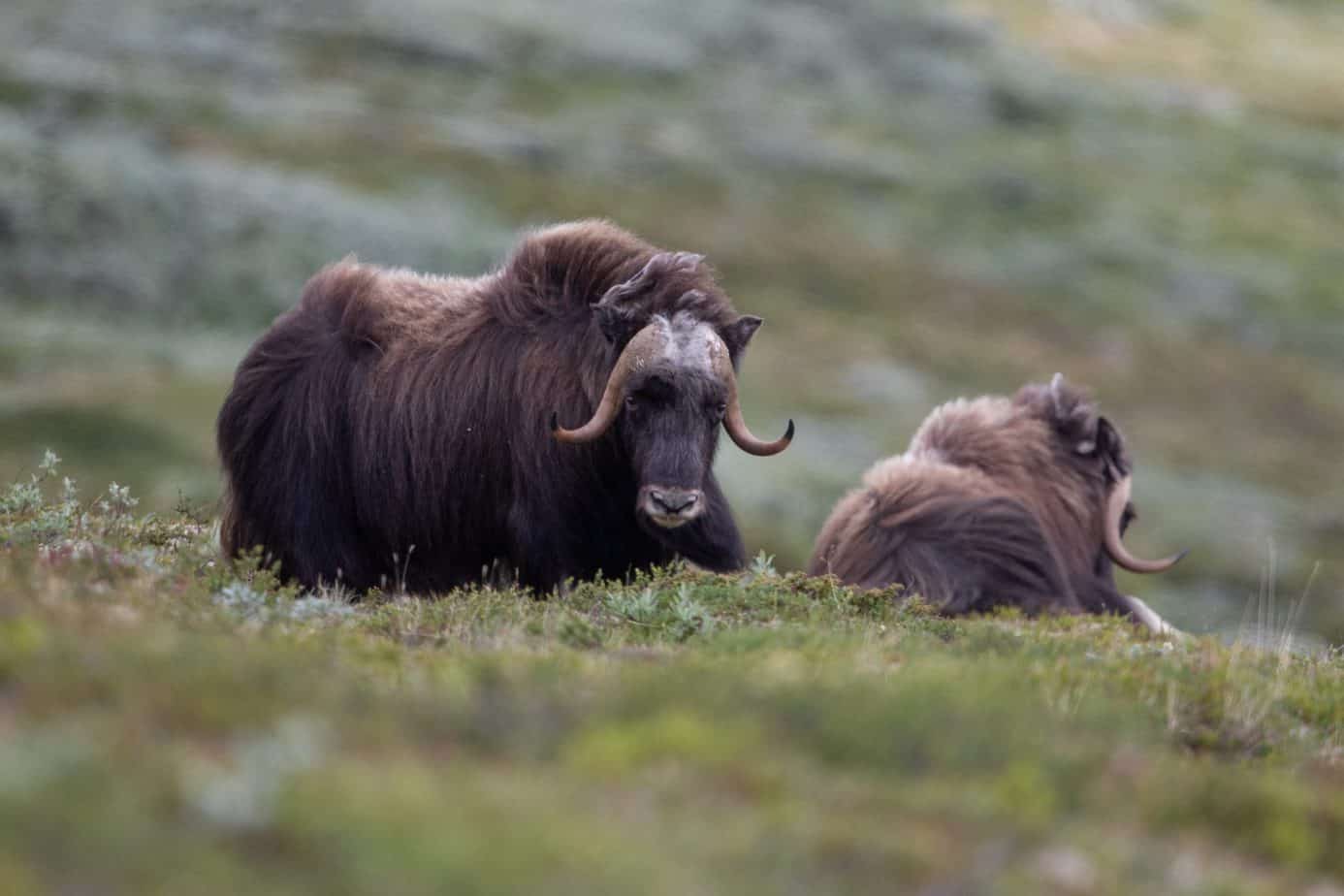
Muskox @ Dovrefjell-Sunndalsfjella National Park. Photo: Håvard Rosenlund

Muskox @ Dovrefjell-Sunndalsfjella National Park. Photo: Håvard Rosenlund
The muskoxen slowly moved away from me, and I found it safest to take the hint and move down from the mountainside. I had just had one of my all time favorite wildlife encounters, on par with experiences I had in Africa. Adrenaline was flowing, and I was very excited to have gotten a few decent shots to show for the experience. The day was still early, however, and there is a trail called the muskox trail (about 15 km long), which would take me back to Kongsvold, eventually. I felt energized and ready for more adventure, so I decided to take it, and at the same time figure out how it would feel to walk around 20 km (I had already walked 7 km at this point) with my equipment (I have a few other grand plans down the road).
Just to confirm I made the right choice to follow the muskox trail, a bluethroat decided to appear and pose for me right at the very beginning of the trail:
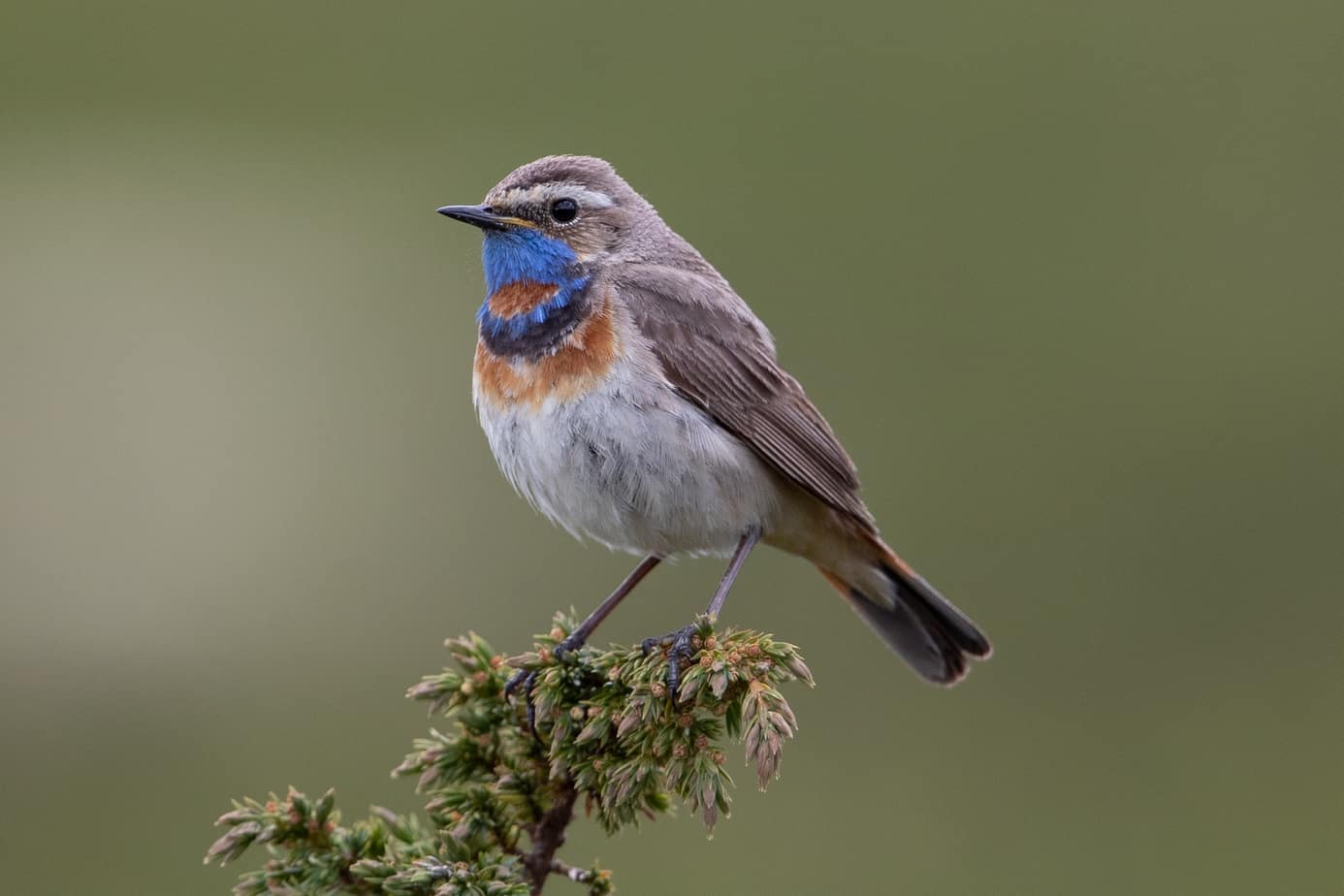
Bluethroat @ Dovrefjell-Sunndalsfjella National Park. Photo: Håvard Rosenlund
As I kept on going, I didn’t see much in terms of wildlife (I heard a raven and saw a few more northern wheatears), but wow, that landscape was incredible! I absolutely fell in love with the area, and it might be because it really do remind me so much of the African landscape, especially parts of the Serengeti. The first part of the trail took me down to the highway (E6), which I had to cross for the second half of the trail. Down by the highway I got a few more decent shots. Here’s one of a willow warbler (Phylloscopus trochilus), which really were all over the place, but they can be hard to photograph, and since they are so common all over Norway, I didn’t bother too much with them.
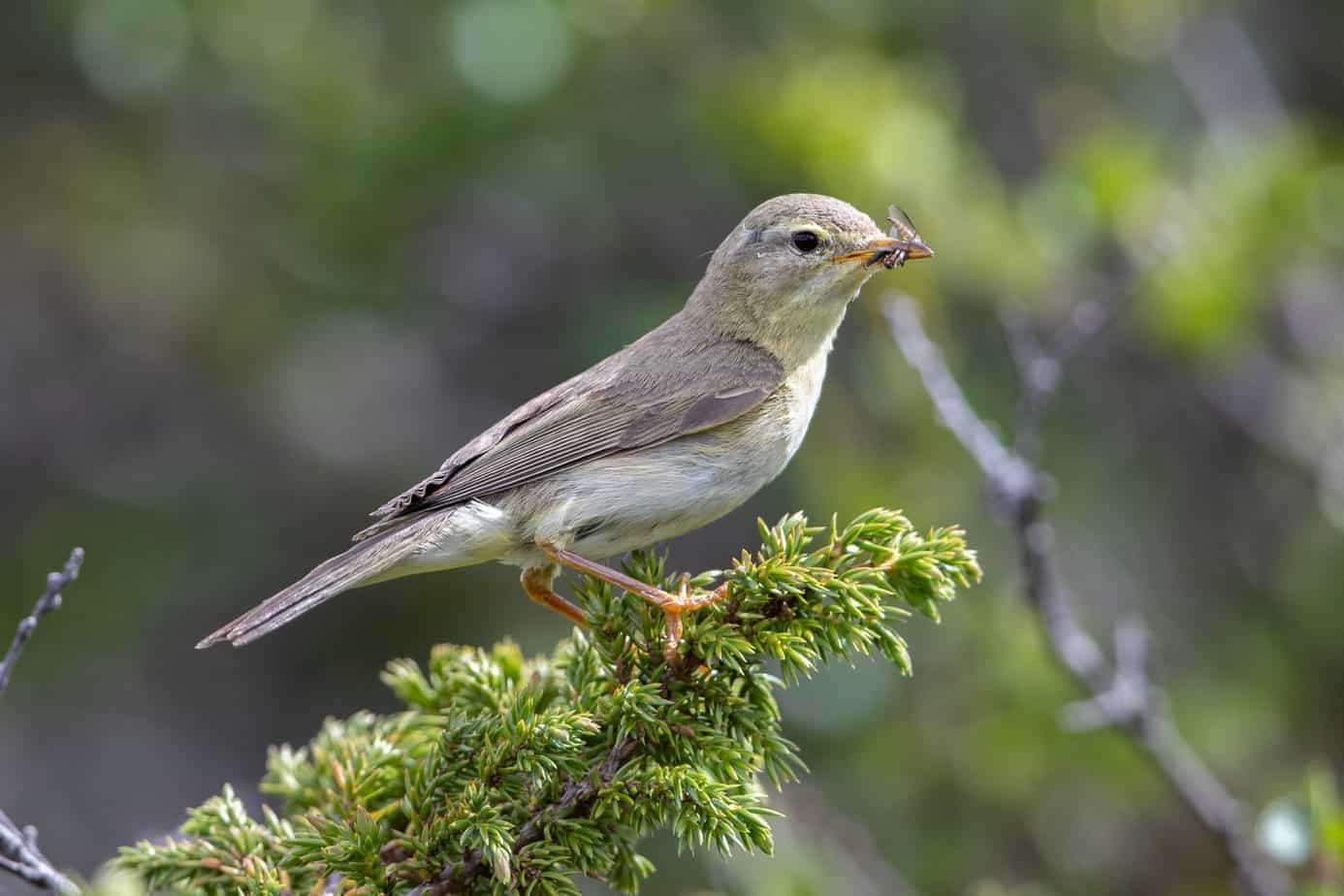
Willow Warbler @ Dovrefjell. Photo: Håvard Rosenlund
As I sat down for a second lunch by the highway (I was getting a bit weary by that point), a few more western yellow wagtails showed up, and one decided to sit right next to me as I ate. I can’t believe how close some of these birds came. This one really wanted his photo taken (and wouldn’t shut up about it!)

Western Yellow Wagtail @ Dovrefjell. Photo: Håvard Rosenlund
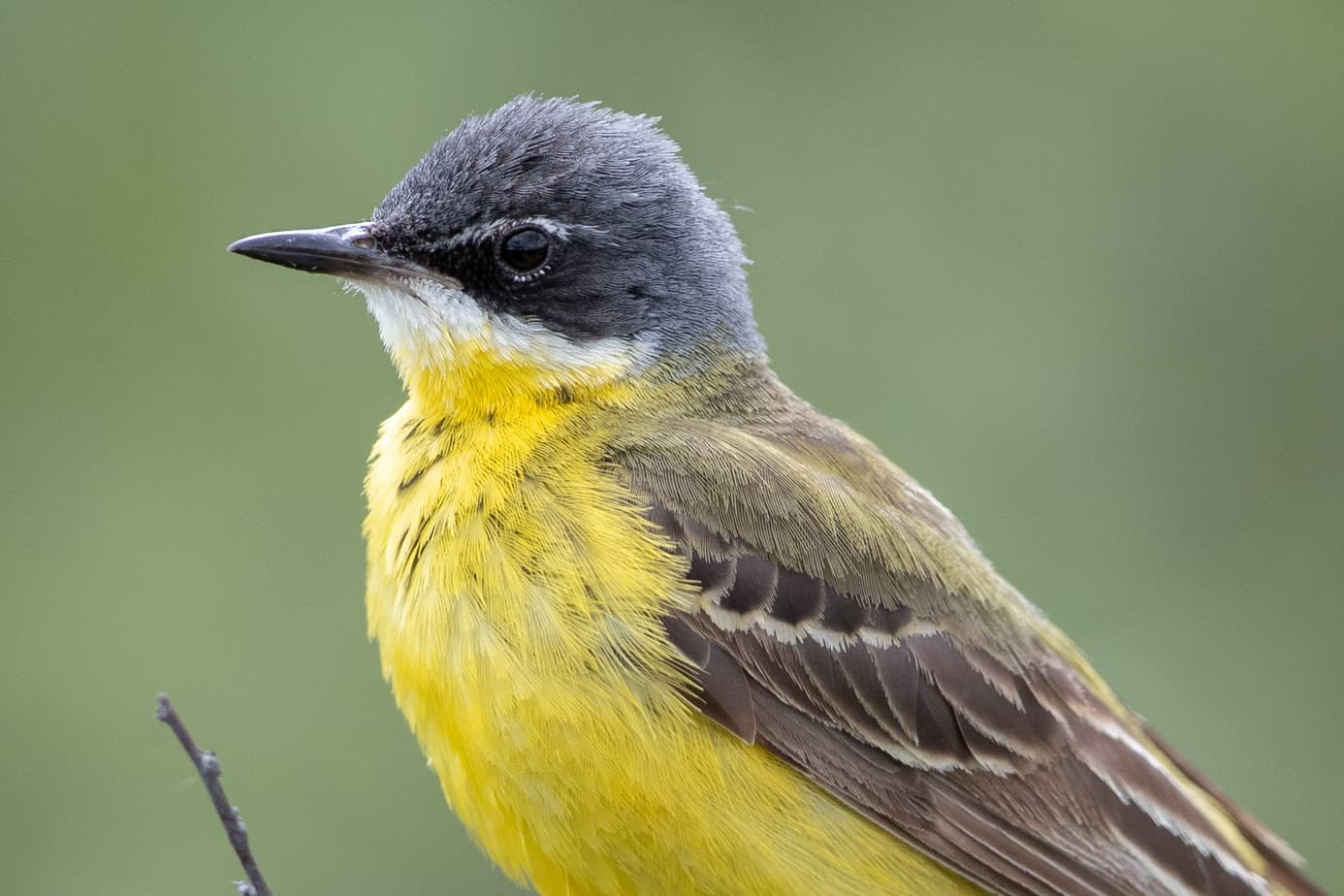
Western Yellow Wagtail @ Dovrefjell. Photo: Håvard Rosenlund
Another meadow pipit wanted to show its presence as well:
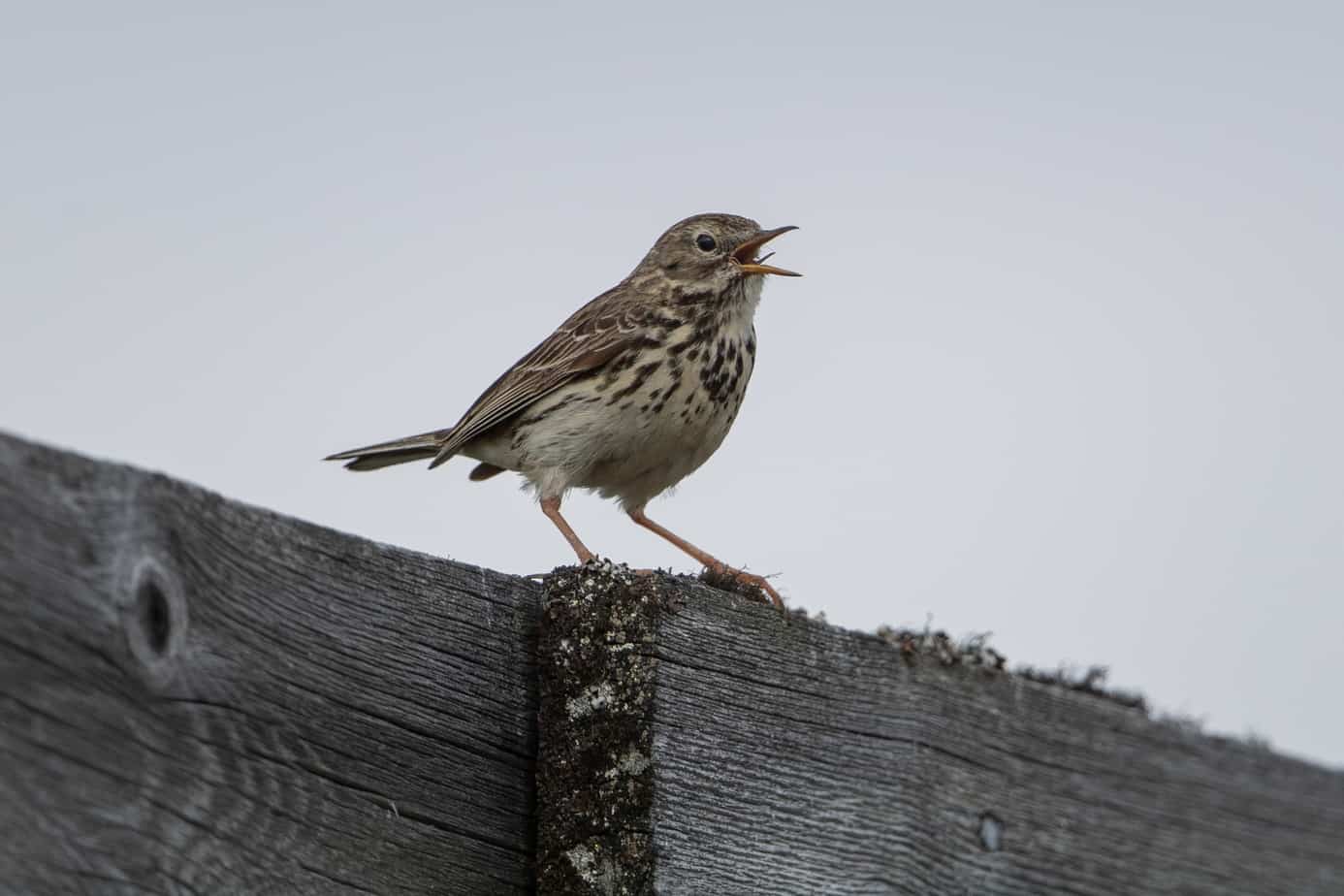
Meadow Pipit @ Dovrefjell. Photo: Håvard Rosenlund
And towards the end of the trail another bluethroat showed up (again!). This one really wanted to flaunt its feathers.

Bluethroat @ Dovrefjell. Photo: Håvard Rosenlund
After a long trail and 10 hours (I had my share of stops along the way) I finally found myself back at Kongsvold Fjeldstue. It was an incredible day and a hike I highly recommend to anyone who likes a nice walk in the mountains (with a chance of muskox on the way). I also managed to find a way of carrying my camera and equipment that didn’t really tire me that much, which was great!
Day 5 (July 9th):
My final day, and another day were I actually had no plans of doing another walk, but I really wanted to check out Fokstumyra one more time before my drive back south. I had met all my initial goals. Bluethroat: check (mulitple times!), muskox: definite check, other new species: multiple checks. There was one thing, however, that had eluded me during the entire trip, which actually ended up as a goal after Wednesday (muskox safari day), but weren’t fulfilled on my long walk on Thursday. I wanted to see a bird of prey (a hawk, eagle, falcon, or similar). I did see an owl, but they are really not the same. There are supposed to be plenty up there, but I had not seen any. Especially one species kept popping up when I talked to other birders in the area, one I had never seen before, but I knew was a very pretty bird of prey: the hen harrier (Circus cyaneus). With that in mind I went to Fokstumyra one last time!
I knew I had made the right choice to come here one last time the moment I turned off from the highway and onto the gravel road towards the reserve parking lot. A Eurasian curlew (Numenius arquata) and its chicks just happened to be on top of a hill close by the road, and the parent even decided to pose by standing on top of a rock. One of my favorite Norwegian birds, and with one of the most amazing bird sounds (in my opinion). It’s not even supposed to be common in the area, but here it was! My first ever good photos of one, as well!

Eurasian Curlew (chick) @ Fokstumyra Nature Reserve. Photo: Håvard Rosenlund

Eurasian Curlew @ Fokstumyra Nature Reserve. Photo: Håvard Rosenlund

Eurasian Curlew @ Fokstumyra Nature Reserve. Photo: Håvard Rosenlund
Another amazing coincidence happened at the reserve parking lot. I met a nice married couple, which I had briefly met during my long walk the day before. They had then been on their own guided muskox safari (same as I had been on the day before), but they had some bird questions and asked me as I passed by their group (something about my camera equipment seems to scream birder for some reason). The husband, an American, is an avid birder and has his own birding tours in Paris, were they both live. The wife is Norwegian, and a budding birder herself. Now, back at the parking lot, they had missed the curlews by the road, so they headed back for them, but we decided to meet up at the bird watching tower later on.
I did my own little walk in the meantime and got another willow warbler. This one got so close I almost had to back off to even get it to fit into my lens!

Willow Warbler @ Fokstumyra Nature Reserve. Photo: Håvard Rosenlund
I didn’t see much else, so I went straight to the bird watching tower and sat there and waited. I stayed there a while without seeing much. It was also quite windy so I decided to get back down and out into the sun. At that very moment, the couple came walking up the path, and I noticed they saw something. I turned my head to see what it was, and it was another short-eared owl flying over the marshlands! A bit too far for photos. After the owl had disappeared we began talking, and we stayed there quite a while, discussing birds, wildlife, and life in general. Suddenly, the husband shouts: hen harrier! And there it was! A male hen harrier suddenly appeared over the open marshlands, as it was hunting low above ground. It was quite far away, but it was no mistake. It really was a hen harrier! The exact species I really hoped to see on my last day! It gradually rose higher and higher up into the sky, and I managed to get a few bad photos (it was really far away, so the image is heavily cropped, but it is proof at least, and you can clearly see its beautiful light grey colors):
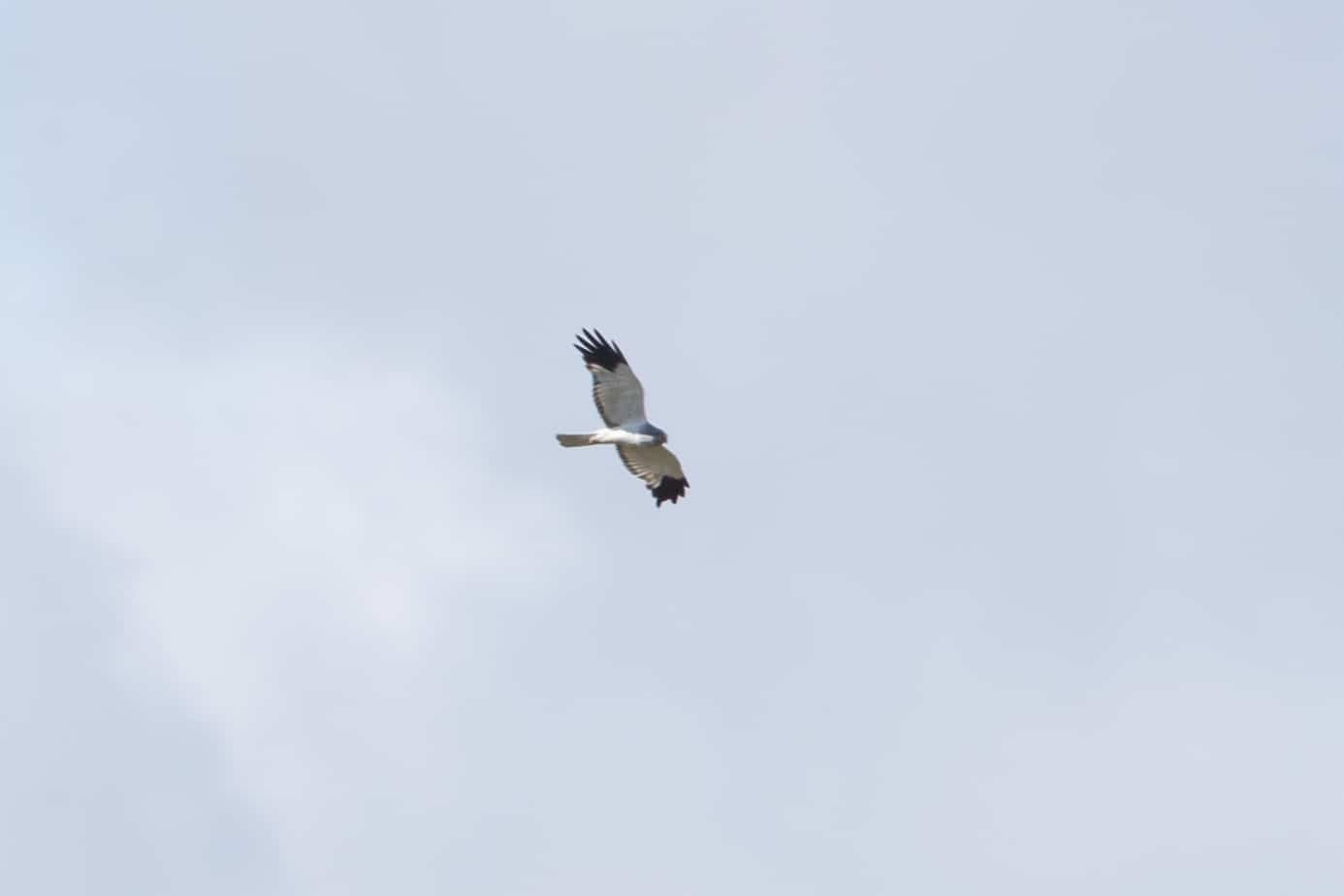
Hen Harrier (male) @ Fokstumyra Nature Reserve. Photo: Håvard Rosenlund
After it had disappeared (and reappeared again further away), we continued talking for a bit, when he suddenly again shouts: hen harrier, and the female this time! And then I had seen them both! Both the male and the female. As you can see by the photo, the female has a very different coloration, as she is brown and more cryptic in appearance.
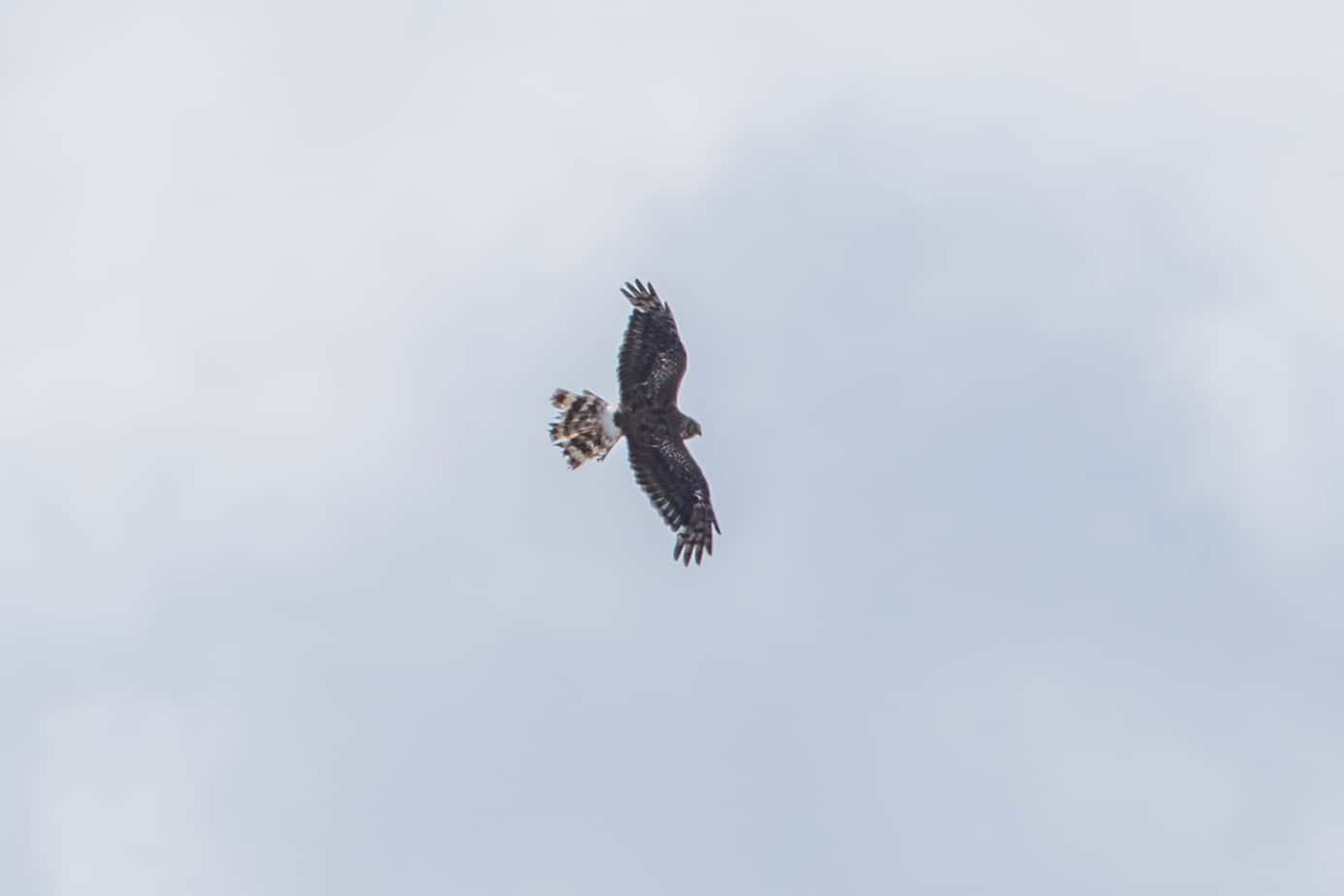
Hen Harrier (female) @ Fokstumyra Nature Reserve. Photo: Håvard Rosenlund
What an end to an incredible trip to Dovrefjell! There are still a few species I haven’t seen, like the fabled Eurasian dotterel (Eudromias morinellus), which the American really wanted to see, and a few more of the birds of prey (and maybe get better photos of them). Safe to say, I will be back again!
Of course the trip could not end without a bluethroat suddenly appearing next to my car to say goodbye as I was changing out of my field clothes getting ready for my drive back south.
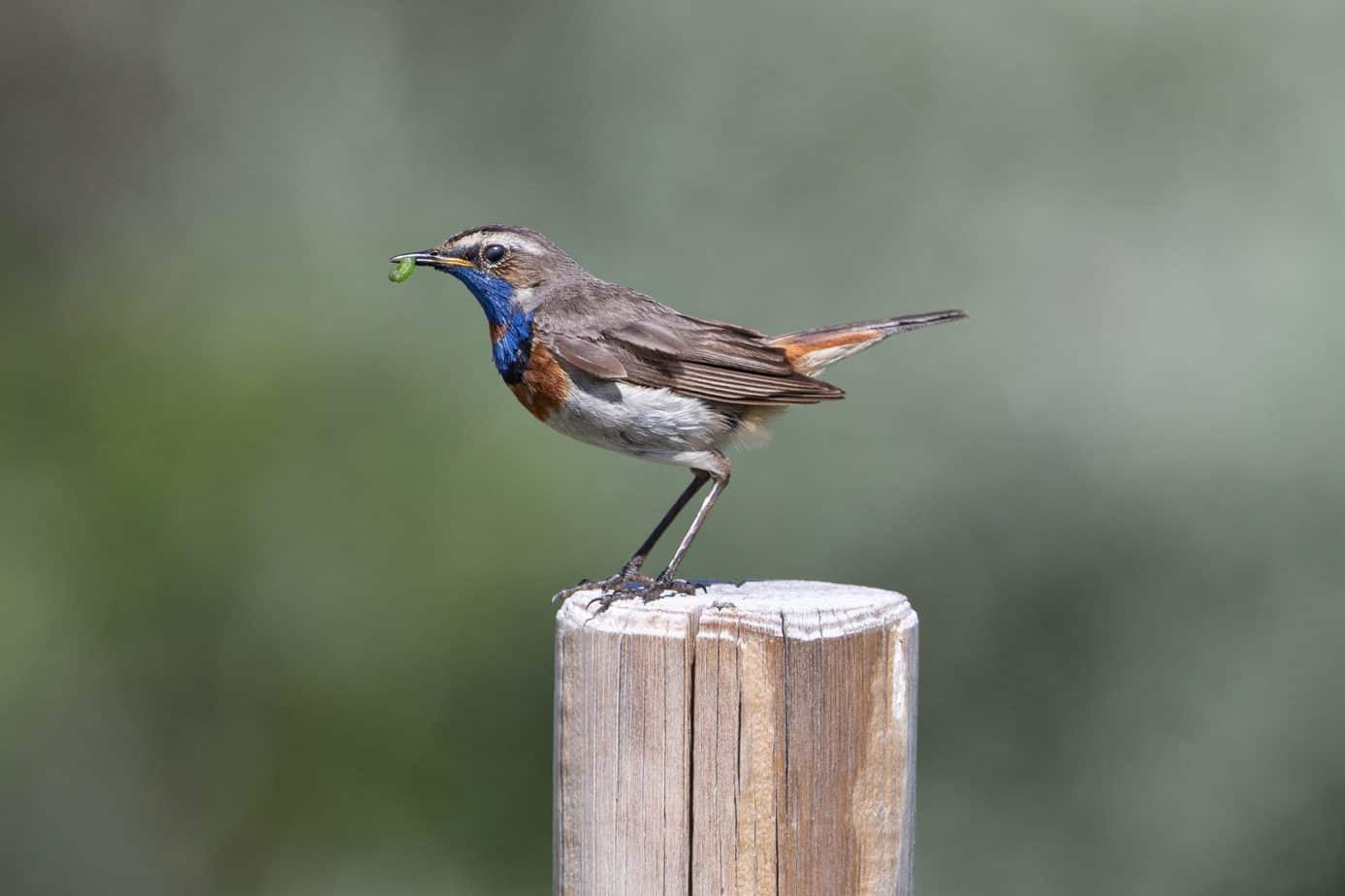
Bluethroat @ Fokstumyra Nature Reserve. Photo: Håvard Rosenlund
Well, if that wasn’t the longest blog post you’ve ever read? Hopefully you enjoyed some of it, and didn’t fall asleep halfway, and I don’t blame you if you only looked at the photos! Let’s see how long it takes until my next update, eh? Five more years? Let’s hope not… I quite enjoyed this one!
As promised here’s a list of all the species names and the Norwegian name besides them (in order of appearance):
Bluethroat – Blåstrupe
Meadow pipit – Heipiplerke
Western yellow wagtail – Gulerle (den spesifikke underarten på Dovrefjell kalles såerle)
Arctic loon / black throated loon – Storlom
Whooper swan – Sangsvane
Moose – Elg (trengte du egentlig den?)
Common gull – Fiskemåke
Common cuckoo – Gjøk
Short-eared owl – Jordugle
Wood sandpiper – Grønnstilk
Common reed bunting – Sivspurv
Muskox – Moskus (tror ikke du trengte denne heller)
Northern wheatear – Steinskvett
European golden plover – Heilo
Common redhsank – Rødstilk
Willow warbler – Løvsanger
Eurasian curlew – Storspove
Hen harrier – Myrhuak
Eurasian dotterel – Boltit


